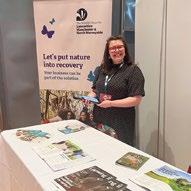
Our Bolton cafe society — Springtime snowdrops — The traditional art of hedgelaying


Our Bolton cafe society — Springtime snowdrops — The traditional art of hedgelaying
Patrons
Edwin Booth
President
Chris Davies
Vice President
Ted Jackson MBE
Honorary Vice President
Baroness Williams of Trafford
Chairman
Julian Jackson
Vice Chair
Hazel Ryan
Honorary Treasurer
Nicholas Williams
Chief Executive
Tom Burditt
Director of Development
Mick Weston
Director of Nature and Wellbeing
Daveen Wallis
Director of Finance
Steve Wood
Editor Jenny Bennion E. jbennion@lancswt.org.uk
Sub Editors
Alan Wright, Lydia German, Amy Shakeshaft
Trust Headquarters
The Barn, Berkeley Drive, Bamber Bridge, Preston PR5 6BY T. 01772 324129 www.lancswt.org.uk
Design www.nectarcreative.com
Cover photography
Nutkin the red squirrel kitten at Freshfield Dune HeathA.J.Critch Wildlife
Lapwing is produced for the Members and Supporters of The Wildlife Trust for Lancashire, Manchester and North Merseyside. Views expressed here are not necessarily those of the Trust.
The Lancashire Wildlife Trust is a Registered Charity (No.229325) and a Registered Company (No.731548) dedicated to the protection and promotion of wildlife in Lancashire, seven boroughs of Greater Manchester and four of Merseyside, all lying North of the River Mersey.
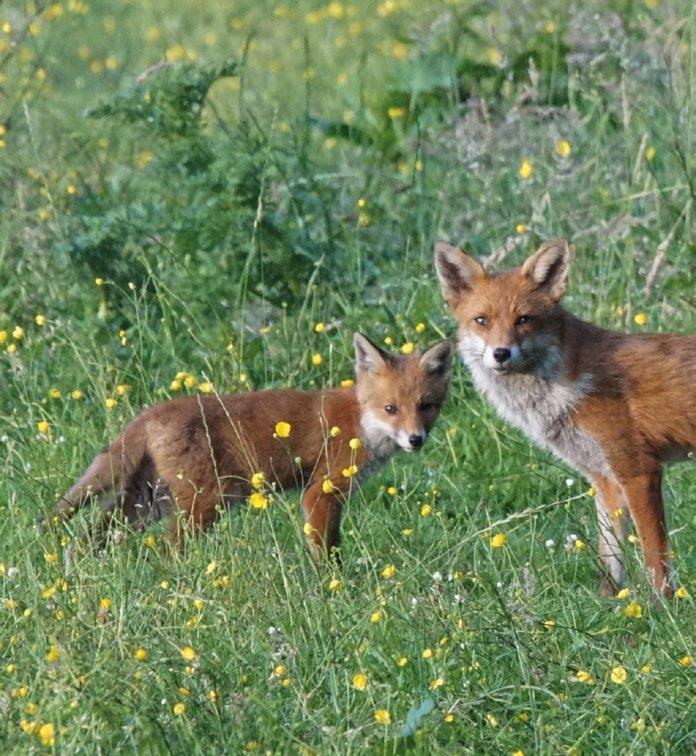
Woolly jumpers, wellies, hats, scarves and gloves - winter’s here and it is a magical time of the year to be out in your garden, park or local nature reserve.
Leaves will be crunching under our feet instead of providing cover on the trees, so wildlife will be more visible in these colder months – look out for roe deer, foxes and badgers in the woodlands and meadows.

Don’t be surprised if some of them turn up in your garden seeking food. Both grub and grubs will also be scarce for birds, raptors will be having longer days hunting, and a lot of smaller birds will need supplementary food on your bird tables and feeders.
It’s a busy time for our staff and volunteers as we work on creating perfect habitats for wildlife on our nature reserves. Say hello to our teams as you are walking around those reserves, they will give you a warm response and tell you what they are up to. They will certainly be keeping warm with their hard work. I am so proud of them all and hope to join them out on the reserves this winter.
"Over

Over the coming months we will be announcing exciting projects around our native red squirrels, and we are launching this with The Big Give appeal where we aim to raise £40,000 for this local project. Our officers have been delighted to meet Nutkin, an orphaned red squirrel kitten, who will be leaping through the woodlands around Formby now, after his release.
I am delighted to announce Simon Owen has agreed to be our first Lancashire Wildlife Trust Ambassador, spreading the word about the work we do. The great thing is that Simon knows about much of this work first hand - his team from Standby Productions have created wonderful films about LWT projects and they are an important corporate member helping to support our work. It is great to have an ambassador who knows the Trust and who is absolutely passionate about nature.
As a rather damp summer rolled into autumn, and politicians huddled together for warmth, it was heartening to see our Youth Council at the Green Party Conference.
The Greens invited us to the conference and were delighted when our newly installed Assistant Officer Euan Norman and other young people stressed the importance of young voices for nature. Euan is writing his debut column in this edition of Lapwing.
It's been busy and it’s not letting up in winter, but your passion keeps the LWT team going, and we are looking forward to another year of making gains for wildlife in the North West. We must ensure that future generations are allowed to experience the wonders of the natural world.
This is a good opportunity to wish you all the best for the festive season and let us all pledge to make this a better world for wildlife in 2025.

Tom Burditt, Chief Executive Officer


Stephen Halliwell shares his love of the snowdrop, one of our most recognisable and best loved flowers.
It’s approaching 12 long months since we last appreciated the company of the humble snowdrop, with all the promises that winter would soon be over, and that spring was just around the corner.
You can spot snowdrops at many of our woodland nature reserves, including Aughton & WoodsBoilton
The snowdrop is one of the first flowers to bloom in the new year. All right, it may be trailing behind the occasional winter aconite with its hot yellow flowers sitting atop its own individual ruff of foliage, or the occasional hellebore in varying shades of pinks and purples, but it’s the one we associate most with the beginning of the New Year.
Despite there being around 20 species of snowdrop, officially Galanthus meaning ‘milk flower’, there are none that are native to this country.
The species nivalis, meaning ‘of the snow’, was introduced approximately 500 years ago from Europe, where it occurred from the Pyrenees in France and Spain, all the way east to Georgia in western Russia.
"There are so many places where massed gatherings of snowdrops draw the crowds, so now is the time to be making your plans to visit them."





If you would like to know more about this fascinating flower, Stephen Halliwell’s recent book, ‘The Snowdrop - An Introduction’ is available for just £12.99 (inc P&P). Send cheques to 29 Minster Park, Preston, PR4 0BY, or telephone 01772 768637 to pay by BACS. Copies sent direct as a gift can include a card saying who it is from.
All 20 species are native to the Aegean and Baltic areas; from Turkey and the Black Sea regions to Ukraine and Western Russia, where a variety of endemic species overlap one another.
Of these 20 species, only four have been used to propagate the thousands of varieties that we are now able to enjoy. One of those, Galanthus plicatus, the pleated snowdrop, was first introduced to this country after the Crimean War in the mid-1850s. The other two are Galanthus woronowii and G. elwesii.
The snowdrop itself is a plant that holds many secrets and is the subject of a selection of myths and legends, many originating in Eastern Europe. In Romania, the festival of Măr ţ işor, or Little March, is known to have existed for around 8,000 years.
In neighbouring Bulgaria, its sister flower is known as Martenitsa, with other variants in Albania and Italy. Snowdrops are a native species in all these areas and have become central to the Măr ţ işor merriments.
At the time of Măr ţ işor, boys tie red and white threads to the stems of snowdrops and give them to their mothers and sweethearts. In modern Romania, the white is said to symbolise the purity of Christ, with the red thread being symbolic of the woman’s fertility and fine health.
There is deeper significance to this flower’s symbolism in Romania, as there the seasons are represented by colours. Summer by green or yellow, autumn by black, winter by white and spring by red. Therefore, the red and white threads are symbolic of the passage from winter into spring.
There are so many places where massed gatherings of snowdrops draw the crowds, so now is the time to be making your plans to visit them. There may be a few species of snowdrop represented among the huge gatherings, but the majority will now be our naturalised Galanthus nivalis, which means ‘The Milk Flower of the Snow.’ Snowdrops’ traditional name ‘February Fair Maids’ may indicate their accustomed arrival time, but climate change is tending to bring their arrival forward, and Kew Gardens now expect their first snowdrop to flower before Christmas.
So, get those walking shoes out and pay a visit to a snowdrop wood, to discover for yourself the reasons why this tiny plant has been the object of poets and writers for hundreds of years and be beguiled by their beauty. Enjoy!
Birds, butterflies and plants are returning to our peatlands, Alex Critchley delves into the wildlife that is making a comeback.

The LWT peat team has been working wonders, restoring moss and moor (or lowland and upland peatlands if you prefer) from drained and damaged wildlife deserts to flourishing ecosystems.
One sure sign that a habitat is on the mend is when the wildlife starts to return, and we’ve been keeping a keen eye on our peatlands to track how the habitat, and the wildlife that relies on it, is faring.
A healthy peatland should be filled with an array of wonderful wildlife. From otherworldly plants to incredible invertebrates, the wildlife that lives and relies on these unique habitats is truly fascinating, wildlife that often doesn’t have anywhere else to go.
With the help of our volunteers and supporters, our peat team have been restoring peatlands across our region – check out what we’ve spotted.
"Curlew are a red-listed bird species and their numbers have drastically dropped by around 48 per cent since 1995."
Darwen Moor
Working through the Lancashire Peat Partnership, last year our peat team started work restoring a heavily degraded patch of Darwen Moor. In the shadow of the iconic Jubilee (Darwen) Tower, restoration features such as dams and bunds were installed to help keep water on the moor exactly where it should be. This helps to re-wet the drained peat, ready for the planting of thousands of plugs of sphagnum moss and other peatland plants – and the wildlife is already taking advantage of the improved habitat.
The pools of water that were created by the bunds have been colonised by large numbers of dragonflies. Ecological consultant, Steve Martin, recorded black darter, common darter, four-spotted chaser, migrant hawker and common hawker, as well as emerald damselflies.
Birds are also starting to flock back to the area. Lancashire Peat Partnership Development and Engagement Officer, Nathan Thomas, spotted an incredible flock of more than 30 golden plover over the moor, a species that is also noted to have bred this season. Golden plover are small and colourful birds and will breed on upland moors during the summer before dispersing to lowland farmlands and coastal areas in the winter.
Even more excitingly, curlew have also been observed nesting in the area. Curlew are a red-listed bird species and their numbers have drastically dropped by around 48 per cent since 1995. Improved foraging habitat has led to increased sightings of these birds on Darwen Moor and as the blanket bog continues to rejuvenate, we hope these numbers will continue to rise.


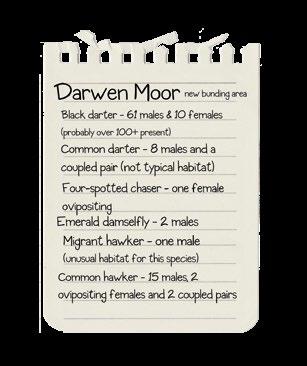


Our work to restore Birch House Farm, an area of former drained peatland fields close to our Winmarleigh Moss Nature Reserve, is proving exciting. The newly boggy landscape has already played host to oystercatcher, shelduck, curlew and breeding lapwing, all of which have benefited from the re-wetted landscape.
Winmarleigh Moss is also one of the few strongholds for the large heath butterfly in our region, and thanks to the restoration works the population has successfully spread and established in new areas of the reserve.
A black-tailed godwit was also spotted by Senior Project Officer, Helen Earnshaw, feeding in a newly re-wetted area of the reserve, again benefiting from the restored water level.
Another red-listed bird, the blacktailed godwit population has suffered significant declines due to intensive agriculture, so this was a particularly heartwarming sight. We are absolutely delighted to welcome these amazing animals back to our peatlands, it certainly shows that we are doing the right thing. However, there is so much more that needs to be done, and more wildlife that needs to return. You can be sure that we won’t be resting on our laurels and will continue to bring
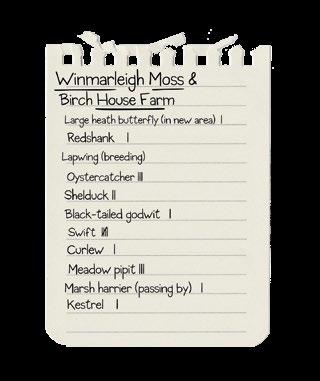

This year we launched Marine Weeks with a splash, hosting a kick-off event to mark the start of a two week celebration dedicated to the wonders of the Irish Sea. Lydia German tells us more.
The sun shone on a summer’s day as all the Wildlife Trusts who border the Irish Sea all held their own version of Irish Sea Day, which celebrates the ocean’s natural heritage and wildlife.
Our celebration took place at Half Moon Bay in Heysham, and Lancashire was just one of 10 Wildlife Trusts collaborating as part of the Irish Sea Network. There were lots of stalls and activities held through the day, such as rockpooling, guided walks, wellbeing sessions, a sea watch, beach art, a bubble station, litter picks, beach bingo and lots of information about coastal projects around the Irish Sea.
Attendees could add their hopes and wishes for the Irish Sea to our Wish Fish, which showed just how passionate everyone is about protecting our sea.
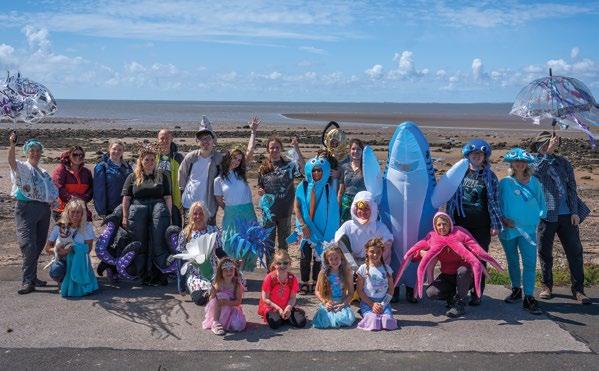

Lizzi Collinge, the new MP for Morecambe and Lunesdale, also dropped by to learn more about our work, particularly about our nature and wellbeing projects. This was the first of many of our planned engagements with MPs about how they can support our mission to work with both people and wildlife to aid nature’s recovery.
The event was a great chance to see some of our marine life up close – particularly common shore crabs, which the rockpools were teeming with. Our dedicated volunteers helped attendees to find them and taught everyone how to hold them safely without getting pinched.
"Attendees
"We are so lucky to have the amazing Irish Sea on our doorsteps, and events like this help us to share the joy and wonder we all find in the fascinating marine world."
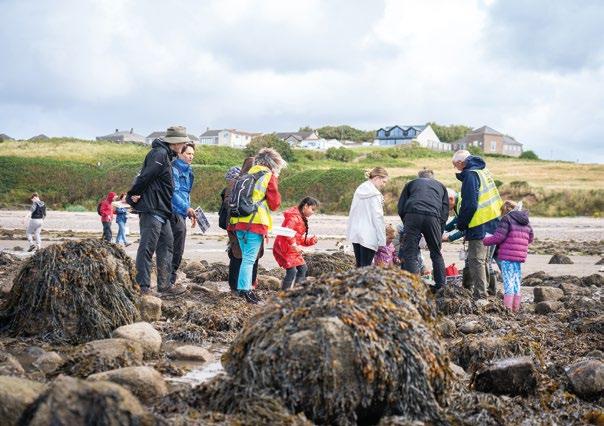
We also learned how to determine the gender of the crabs and other interesting factors to look out for, such as an orange mass on their stomachs, which are eggs. Females carry fertilised eggs with them to protect them from predators. Towards the end of the event, we all enjoyed the amazing fancy dress parade led by The Baybeat Street Band.
Everyone dressed up with a marine theme to raise awareness of the wonderful wildlife in our oceans –outfits included a deep-sea diver, a shark, queen of the ocean, an octopus and many more! We are so lucky to have the amazing Irish Sea on our doorsteps, and events like this help us to share the joy and wonder we all find in the fascinating marine world.

We’d like to give huge thanks to our partners at the event who ran stands and helped the day to run smoothly: The Fylde Sand Dunes Project, Fylde Council, Living Seas North West, Park View 4U, Our Future Coast, Morecambe Bay Partnership, North Lancashire Wildlife Group and The Bay: A Blueprint for Recovery.
could add their hopes and wishes for the Irish Sea to our Wish Fish, which
passionate everyone is about protecting our sea.
Jenny Bennion delves into the world of our red squirrel conservation project.
Back in summer I met Nutkin, not the actual naughty but beloved character from the famous Beatrix Potter story, but the latest in a series of orphaned baby red squirrel kittens that was being cared for by our amazing Red Squirrel Project Officers, Molly and Melissa.
Rescued from a garden in Formby where he was found alone and unable to feed himself, Nutkin was given a health check by a vet before taking up residence in Melissa’s home for his four hourly milk feeds, bringing him back to health until he was ready for solid foods.
Just a couple of weeks later, the access hatch in the roof of the pen was opened, and Nutkin ventured off into the woodland to start his life as one of our precious population of Formby red squirrels.
Red squirrels are now considered at risk of extinction in the UK, with the population plummeting from 3.5million to just 290,000. Along with habitat loss and fragmentation, it was the introduction of the non-native grey squirrel from North America in the 1800s that severely affected the fate of our native reds.
"We are so lucky to still have a population of red squirrels in our area, but caring for these precious creatures is a long, hard job and there is always so much more that we want to do.
Four weeks later, I met Nutkin in the soft release pen at Freshfield Dune Heath. Right next to the edge of the woodland, the pen is roomy and filled with branches for him to practice climbing and scampering around on.
A scattering of nuts, seeds and fruit was provided on a platform, along with any foraged green pinecones that the team could find to help him practice the vital skills of nibbling them open to find the nutritious seeds inside.
Grey squirrels are larger and able to outcompete our native reds for food and breeding habitats, and they also carry squirrel pox. Whilst the virus doesn’t affect grey squirrels, it is almost always fatal to red squirrels, with outbreaks causing populations to crash. But there is hope.
Red squirrel conservation projects across Lancashire, Northumberland and Cumbria Wildlife Trusts, Knowsley Safari Park and a Scottish partner are joining up to form the Red Squirrel Recovery Network.
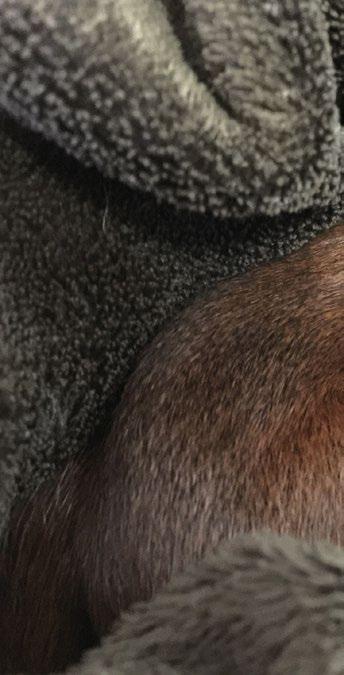

Partners will work together to undertake extensive monitoring providing vital baseline population data, volunteer groups will be identified and supported, and further volunteers recruited and trained.
Field trials will also be conducted into the delivery method of fertility control for grey squirrels, building on emerging science and creating new methodologies which could potentially be transformative for the future of our beloved red squirrels.


We are so lucky to still have a population of red squirrels in our area, but caring for these precious creatures is a long, hard job and there is always so much more that we want to do.
That’s why we are asking you to donate to The Big Give appeal. We are aiming to raise £20,000, which will then be matched by The Big Give, meaning a total of £40,000 could be going directly to our red squirrel project.
If there is a time to support us, it is now, when your donation will have double the impact.
Red squirrels simply wouldn’t exist in Lancashire and Merseyside without the efforts of our dedicated staff and volunteers. If you can, please donate to The Big Give via our website.
Thank you.
EDWARD BAILEY Head of Commercial
JENNY BENNION
Senior Communications Officer
TOM BURDITT Chief Executive Officer
STEPHEN CARTWRIGHT
Greater Manchester Senior Project Officer
STEVE COWELL Contracts Manager
LUCY COXHEAD Fundraising Manager
ALEX CRITCHLEY Peatlands Communications Officer
CRIS DAVENPORT
Manchester Project Officer
LYDIA GERMAN Senior Content & Campaigns Officer
STEPHEN HALLIWELL Guest Author
JENNY JOHNSON Head of Marketing & Income Generation
MEGAN KELSALL Partnerships Manager
JO KENNEDY Head of Landscape Nature Recovery
JAMIE LAWSON Peatland Reserves Recovery Officer
REUBEN NEVILLE North Lancashire Senior Reserves Officer
EUAN NORMAN Youth Council Assistant
AMY SHAKESHAFT Communications & Campaigns Assistant
HANNAH STEVENSON Marketing Manager
MATTHEW SWIFT Marketing Officer
KIRSTY TYLER
Nature & Wellbeing Communications Officer
ANNA-MARIA WHITE
Action for Nature Communications Officer
ALICE WOOD
Marketing Support Officer
ALAN WRIGHT
Head of Campaigns and Communications YOUR LAPWING
Don’t miss a visit to our cafes in Moss Bank Park or Queen’s Park in Bolton
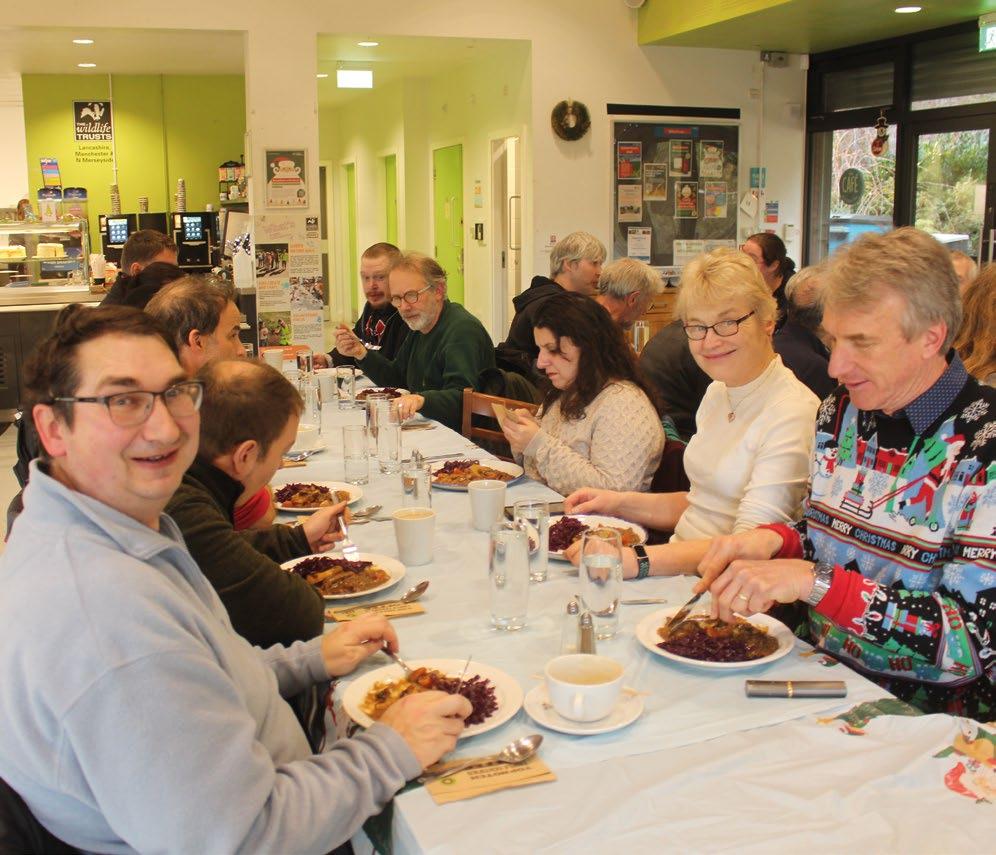
Ed Bailey shares the latest developments from our community hubs in Moss Bank Park and the newly acquired Queens Park café in Bolton.
Our cafés in two of Bolton’s major parks are more than just places for refreshments; they are central to our mission of connecting people with nature, fostering environmental education and enhancing community wellbeing. Additionally, they contribute financially, helping us fund our work in the area.
Moss Bank Park is hugely popular with a diverse range of people and our café has become a meeting place for local nearby residents, offering so much more than just coffee.
Located near The Hive, where visitors of all ages get closer to nature, the café supports a wide range of community and environmental activities. In The Hive, children can explore, learn and connect with nature through activities like bug hunting, den building and seasonal workshops.
Beyond seasonal events, the café supports significant educational opportunities. This year alone, our education team secured £120,000 in funding to provide free naturebased educational opportunities for Bolton’s school children.
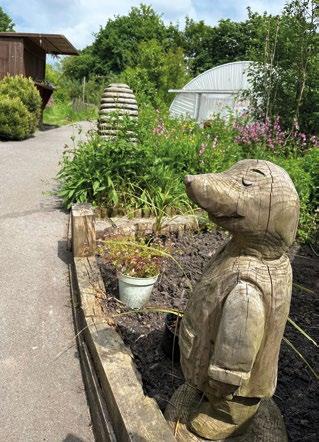

"Many visitors might not typically explore our nature reserves, but the welcoming environment in the café provides an opportunity to meet them."
Our work in Bolton, much of it centred in Moss Bank Park, has attracted over £5 million in funding for various environmental and community projects.
Building on the success of our Moss Bank Park initiatives, we are thrilled to announce the acquisition of a new café, conference and event space in Queens Park, Bolton. This venue presents an incredible opportunity to extend our impact in a new and wonderfully diverse neighbourhood.
Over the next seven years, we plan to create more than 10 permanent jobs, deliver over £1.6m worth of volunteer hours, and provide £86,500 worth of free naturebased activities and events for the local community.
The Queens Park café will also support our Nature and Wellbeing activities, focusing on improving mental health and wellbeing through green social prescribing. By connecting people with nature, we aim to reduce social isolation, enhance physical and mental health, and promote involvement in the environment.
These cafés play a significant role in reaching new people and communities. Many visitors might not typically explore our nature reserves, but the welcoming environment in the café provides an opportunity for us to meet them.
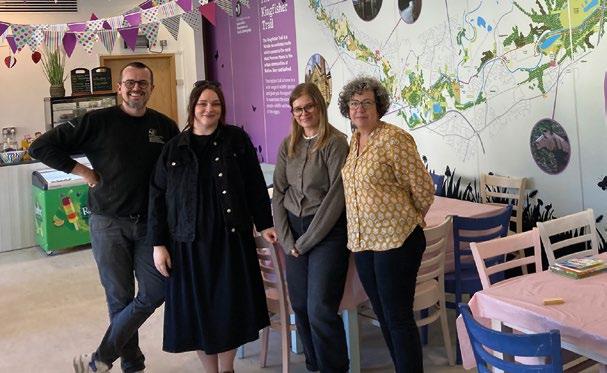
Through nature-themed events, workshops, or simply chatting over a cup of tea, our staff can share the importance of local nature and wildlife. These interactions are crucial for encouraging individuals to support our mission, contributing to our goal of having one in four people take action for nature.
At both of our Bolton cafés, we offer a wide range of activities, particularly focusing on children. With Christmas approaching, we anticipate hosting over 500 children across both sites for various Christmas and nature-themed events.
As part of our commitment to the community, we will provide a number of free places to local residents who might otherwise be unable to participate. Last year, for example, we invited children in foster care to a special Breakfast with Santa event and organised a private gathering for new mothers experiencing social anxiety, supported by outreach workers.
Our work in Bolton extends far beyond the cafés themselves. In Moss Bank Park, we have restored 9.8 hectares of land to promote biodiversity. Our education team provides accredited training and qualifications to local teachers, enabling them to deliver Forest School programmes.
Through the Holiday Activities and Food program, we offer nature-based learning and meals to children eligible for free school meals.
Together, these two vibrant community hubs are building a greener, more connected future for Bolton, fostering a deeper appreciation for nature, and enhancing the wellbeing of all who visit.
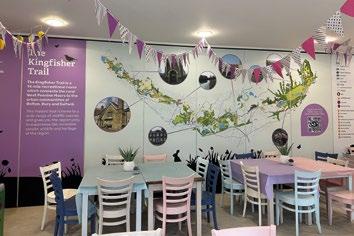
It’s amazing when you start looking into it how much history there is in the words we use to define our native wildlife species, with many having been around for hundreds of years and coming from a range of different root languages. Let’s go on a trip through Old English, Celtic, French and Greek.
Looking firstly at our Wildlife Trust logo, the badger. Badger as a word seems to have been around from the 1500s, however the origins seem to be split –some think it comes from the French ‘bechar’ which means to dig, with other sources suggesting that it refers to the ‘badge’ of stripes on their head.
Many of you may know the old English name for a badger, Brock, which is borrowed from Celtic (Gaelic and Welsh), and is a common prefix on place names all over the UK - Brockholes and Brockbottom to think of some local examples.
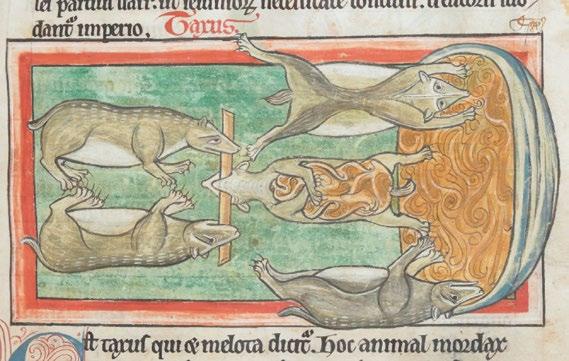


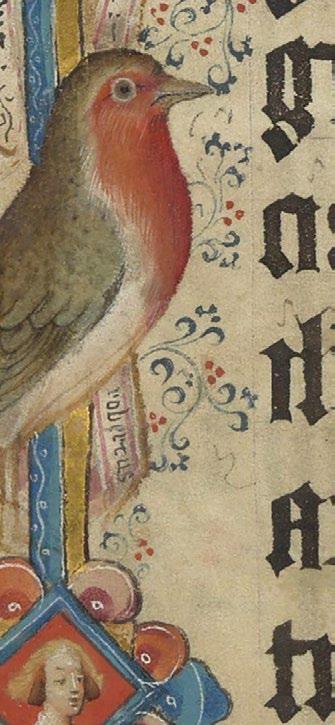

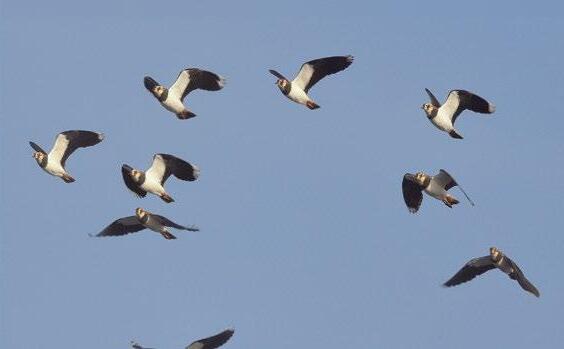
Next, to the name of this very magazine, lapwing. The name is a descriptive one from old Englisha ‘leap with a flicker in it' - because the dense winter flocks appear to flicker between white and black when the birds flap their wings.
Depending on where you live, you may have also heard them called ‘Peewit’, ‘Pewit’ or ‘Tuit’ based on their distinctive calls, and they are also called ‘Green Plover’ in some areas.
A friend to gardeners everywhere, the name of this humble flycatcher has a more unusual history. Robin is a pet name for Robert and comes from the fashion in England hundreds of years ago for giving animals human names. You'd have also had Jenny Wren, Billy and Nanny goats, Jack and Jenny for donkeys, and Jack and Jill for stoats.
So, a redbreast, as they were originally called (along with ruddock) became robin redbreast, and while many still affectionally do call them their full names, mostly we have just stuck with the robin part.
Another common garden species is the dandelion. This one comes from the French - ‘dent de lion’ or lion’s tooth, referring to the jagged shape of its leaves, and the English have stuck with this name. Modernday French however calls it ‘pissenlit’, which translated means ‘wet the bed' due to the plant's diuretic properties.
Dolphin has its roots in ancient Greece, and indeed, dolphins are featured heavily throughout Grecian art, architecture and mythology. Dolphins were associated with the Greek god Dionysus, and killing them was punishable by death in ancient Greece. The word itself comes from the Greek word ‘delphus’, which means womb, so it can be translated along the lines of ‘fish with a womb’.
Language is consistently evolving and changing, much like the natural world which adapts to what’s thrown at it. It’s so interesting to see where words that we as naturalists use on a regular basis have come on their long journey to the 21st century.
Some may even call it a migration...
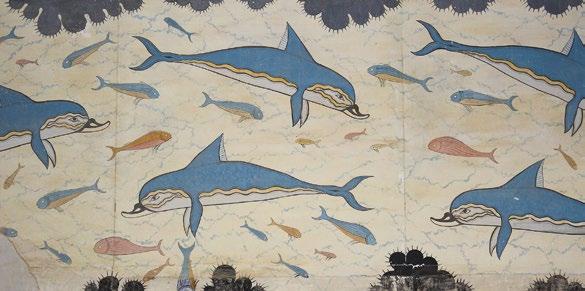
Simon Owen , Managing Director of video production company Standby Productions, talks to us about being our first Lancashire Wildlife Trust Ambassador.


Have you always had a love of wildlife?
I think my love of wildlife has always been there. My Dad, Peter, got me into it at an early age by going birdwatching - and me no doubt complaining that I was bored! However, these things pay off in the long run and it taught me to really appreciate nature and the act of just sitting, waiting and watching.
I always think, it’s in these moments that you answer questions you’ve yet to ask.
I remember, as a kid, having a poster of a kingfisher on my bedroom wall, right next to my football heroes. I think deep down I always wanted to try and capture a photo as good as my kingfisher poster. It was always the bird we never saw - it took my dad 25 years to finally see one. Then I researched, planned, plotted and dedicated myself to filming/ photographing a kingfisher (probably my favourite species) for about a year before finally spending some magical moments with one, that then became a whole family of kingfishers, near Didsbury.
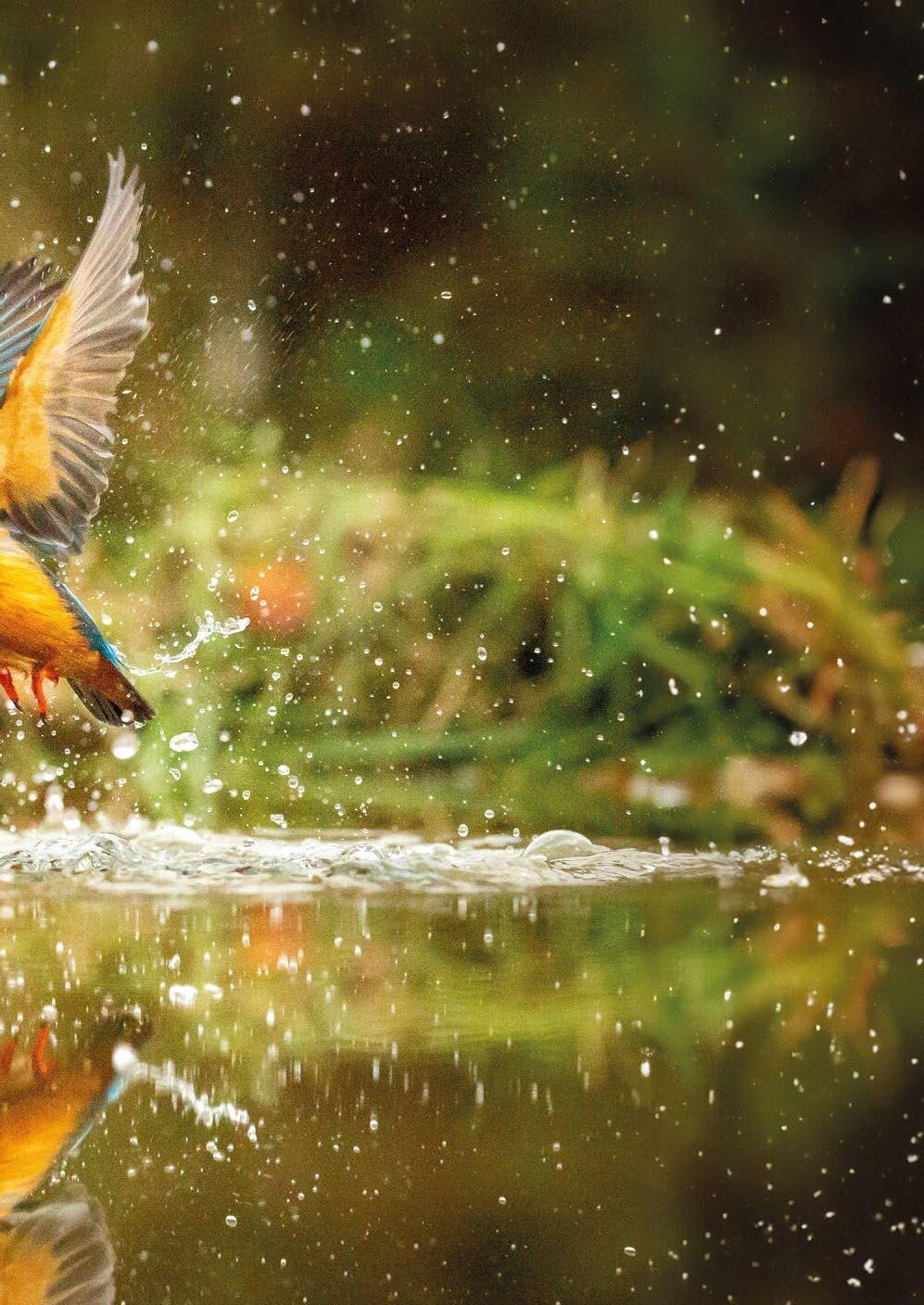
"A deep connection with nature and wildlife has always been there for me, so I wanted to bring it into the DNA of Standby, and make my business do good for people and the planet."
How did you first get involved with Lancashire Wildlife Trust?
When I started Standby Productions, the aim was always to create really cool, creative and unique promotional films and adverts, which in turn meant that I felt I had to hide away my inner bird nerd. However, following the pandemic, I could feel the world finding solace and connection with nature - like we’d all realised it’s actually super important to our health and wellbeing.
A deep connection with nature and wildlife has always been there for me, so I wanted to bring it into the DNA of Standby, and make my business do good for people and the planet. I reached out to LWT, and I very quickly learnt (and felt) that this was the perfect charity to support.
What I loved was that any donation or help we offered would have a positive environmental impact right on our doorstep. This really appealed to me and when I began to learn all about peatlands and how powerful they are for the planet, my natural response was to make a film about it, which we donated to the Trust, along with an ongoing donation of one per cent of our turnover.
Since the partnership started three years ago, I have been totally blown away by the commitment and passion of the people behind the scenes doing the amazing work they do. And not only that, how genuinely lovely everyone is there as well, it’s inspirational. I can say, without any doubt, that this partnership is the best thing I’ve ever done within my business and makes everything we do feel good.
What are you hoping to achieve in your role of LWT Ambassador?
I have to start by saying how unbelievably honoured and humbled I am to have even been asked to be your ambassador.
My main aim is to put the importance of nature and wildlife into more people’s minds. I think it’s easy in an echo-chamber with people who are already passionate about such things, but I’m still so surprised how many people I meet that just don’t think about it or have an awareness of how fragile the planet is.
I want to encourage more businesses to support LWT and to consider their environmental impact, no matter what size of business they are. I feel there’s always something that can be done to minimise impact or have a positive effect.
Andy said it perfectly in our peatlands film; “you can do whatever you want, so why not do something positive?” This is absolutely the way I feel, and I want to speak to more people, encourage positive action, make a difference, and make nature and wildlife cool, whilst being relatable to everyone.


Stephen Cartwright and Cris Davenport introduce us to some of the exciting new technology that is revolutionising our reserves.

Restoring and maintaining habitats, caring for livestock, and surveying and monitoring wildlife are all vital parts of our work, but undertaking all of these jobs to the highest of standards in an increasingly challenging funding landscape can be difficult.
Along with the amazing work and support of our volunteers and members, there are also some exciting new pieces of kit that are making a real difference to many of our most important conservation tasks.
If you have visited our Brockholes, Cutacre, Lunt Meadows, Freshfield Dune Heath, Freeman’s Pools or Lightshaw Meadows nature reserves, you may have come across some of our wonderful conservation grazing cattle. The eagle eyed amongst you may also have spotted the collars they are now wearing. Looking a bit like a traditional Alpine cowbell, these are in fact the latest herd-management technology, NoFence collars.
Funding from The Halpin Trust paid for these collars which use GPS to track the movement of the cattle around our sites.
A simple mobile app lets our conservation officers create virtual boundaries, which an auditory signal stops the cattle from crossing. This means that these wonderful four-legged members of our conservation team can be directed to exactly where we need them with minimal stress to the animals and just a few simple taps of a phone.
Mimicking the behaviour and impact of their historic forebears, bison and aurochs, the grazing habits of our rare-breed English longhorns contributes to a varied sward composition.
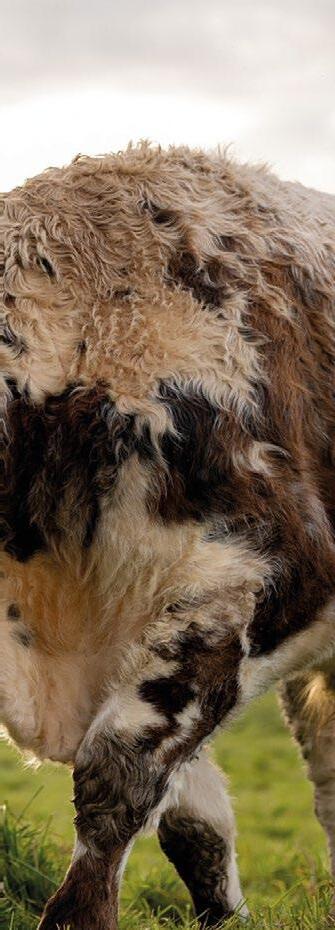
Their lovely tramply hooves create small patches of bare ground and break up scrub, and at our Cutacre nature reserve, the NoFence collars have even been used to guide the cattle to grazing on rush, which they would often avoid.
"We pride ourselves in being a sciencebased organisation, and these, amongst other, new technologies are allowing us to do our wonderful job even better."


Could you help us to care for our amazing conservation grazing animals? We are always on the lookout for volunteers to check on our animals. Find out more at lancswt.org.uk/ volunteer
This helps to reduce the dominance of this (and many other) invasive species. All of this helps to create the perfect conditions for a range of lovely native wildflower species to return.

Environmental DNA
But it’s not only our larger animals which are benefitting from cutting edge technology. Surveying and monitoring aquatic populations is a vital part of much of our work, but one which is time consuming and quite often depends simply on what happened to swim into your net at the time of sampling.
Environmental DNA (eDNA) is the process of taking a water sample and sending it off to a lab where the DNA present in the water, either from faeces, urine, hair or skin cells etc, can be isolated and the species it came from identified. Not only is just grabbing a water sample a far quicker job for our staff and volunteers, eDNA also gives us a much more accurate picture of the species that are, or have recently been, present.
Our project creating and restoring ponds for great crested newts has used eDNA successfully. Previously surveying for these elusive creatures involved either laborious visual surveys looking for signs of their presence, or using bottle traps, neither of which were 100 per cent accurate.
However, using eDNA has allowed a much more robust picture to be built up of where the newts were or weren’t present. eDNA is not just for newts though. With funding from the Swire Charitable Trust, we have also been using this technology for a broad spectrum analysis called metabarcoding. This testing gives us a snapshot of any wildlife living in or visiting the pond by comparing the samples to a DNA database. We recently received our results from Nature Metrics labs, and across 18 ponds they identified 176 individual species including voles, red deer, and four invasive species which we can now track much more easily.
Here at Lancashire Wildlife Trust, we pride ourselves in being a science-based organisation, and these, amongst other, new technologies are allowing us to do our wonderful job even better.
What’s your favourite winter plant? The holly gets a lot of love – who doesn’t enjoy seeing those beautiful bright red berries on a dark day, or watching as the mistle thrush or the redwings polish them off. Or even better – an irruption of waxwings feasting on them?
I always think that ivy’s reputation is unfair. Christmas carols laud the holly’s berries, but ivy berries are an essential part of winter food for all sorts of species, especially as they are long lasting and ripen late into winter and even early spring. They tend to be around long after the holly, sorbus, hips and haws have been stripped by hungry avian mouths. They also have a high fat content, appealing to wood pigeon, thrush, blackcap and blackbird.
Ivy’s greeny-yellow flowers are the last of the season and as such they are a vital late source of nectar, pollen and essential energy before winter hibernation for a whole variety of insects, especially bees, wasps, and hoverflies, but also for autumn-flying butterflies such as the red admiral.
And all manner of wildlife will hibernate in the dense foliage of the ivy, everything from insects, including those lovely red admirals and other over-wintering butterflies, to bats.
Living on the Morecambe Bay limestone as I do, I have another favourite winter plant which is always most noticeable at this time of year and keeps me company on chilly walks through the woods near my home - the spurge laurel.
"Christmas carols laud the holly’s berries but ivy berries are an essential part of winter food for all sorts of species, especially as they are long lasting and ripen late into winter or even in early spring."
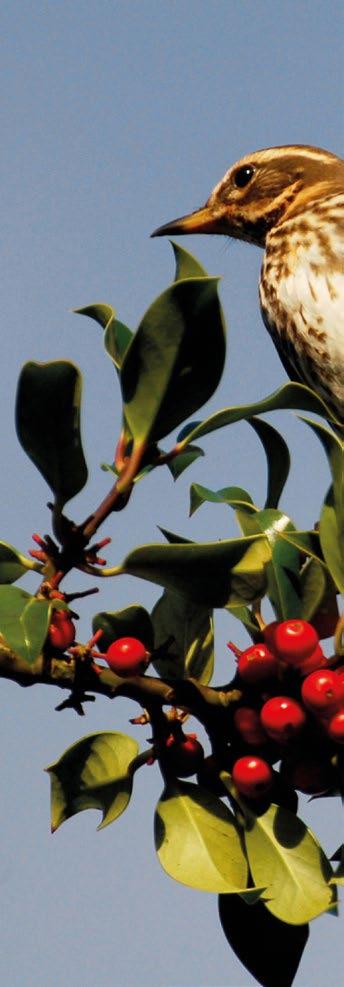
It’s a very curious and unusual looking plant in lots of ways, despite its name it is neither a laurel nor a spurge. With its glossy dark green leaves it looks a bit like a tiny rhododendron and although it’s described as a shrub its stems aren’t very woody (much less so than a cabbage or broccoli plant, and they’re never described as a shrub), I’ve never seen one taller than 1 metre high, and it isn’t bushy. But it is certainly more robust and substantial looking than many perennial herbs and flowers.
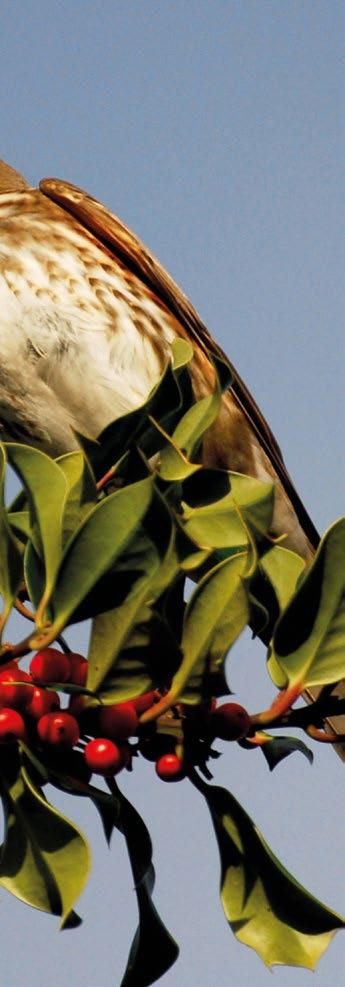
As all parts of the plant are poisonous (diarrhoea-inducing) to humans so it isn’t collected and brought into homes as part of any Christmas or midwinter traditions. But its small, fragrant, honey-scented, green flower clusters appear right through the winter when nothing else is flowering, food for what few insects are around.
And its black berries are not poisonous to birds and might make the difference between life and death for those caught out in a winter cold snap.




I love anything with folklore attached to it, and the spurge laurel’s poisonous nature means it was traditionally associated with the devil and magic. It was said that witches would use the plant to poison their enemies.
Its toxins were also used to treat rheumatism, gout and skin conditions in small and specially prepared doses, and some modern studies have suggested that the plant may have anti-inflammatory and anti-carcinogenic properties.
Its sweet smelling essential oils have also been used in perfumery, and its bark to produce a yellow natural dye.
So please, get outside and enjoy our winter world, maybe giving thanks as you go for those tough plants who are working so hard to keep our wildlife going.
Waxwings and wagtails can turn up in the most unexpected places, says Amy
Whilst the winter months may seem drab and dark, you never know where you might get treated to an unexpected wildlife encounter, and there are birds that like to surprise us.
Wayfaring waxwings
Waxwings are so-called because of the red patches of waxy secretions on their secondary wing feathers. These tropical looking beauties can arrive in huge flocks from October onwards and might turn up anywhere from town centres and domestic gardens to local parks and supermarket carparks.
These flocks are called ‘irruptions’, a name befitting of their sudden appearance in droves. But they are never guaranteed. Some years we may only see a handful of waxwings, but other years if the supply of berries in their native Scandinavia is low, they will cross the North Sea in huge numbers to try their luck. For some of our followers and keen birders, waxwings’ nomadic wandering and irregular irruptions are a phenomenon, inspiring a treasure hunt to spot them before they disappear from our island again in spring.
In these years, our social media lights up with sightings and stunning images from excited wildlife watchers who are thrilled to find that waxwings have descended on our towns and villages once again.
What seems to delight us most is that they hang around in the most unlikely of places. You will likely see a tree laden down with an irruption of waxwings when pulling into your supermarket carpark for the weekly shop.
Why do they stop off in chilly Britain? And why might you seem them in built-up town centres or in supermarket carparks? Because they love berries, particularly rowan and hawthorn, which are commonly planted in these urban places.
They also love cotoneaster and rose, so if you’re hoping to attract these visitors to your garden be sure to plant these varieties. Britain is a berry rich island, and we are lucky to host these partial migrants, even if only temporarily.
Happily, waxwings are classified as green conservation status, meaning their numbers are good and they are doing well. The seeds of fascination for these birds are also sown by the fact that waxwings are simply stunning. With a tropical mix of graceful greys, browns and apricots with pops of sunshine yellow and red, they are a distinctive, exotic sight.

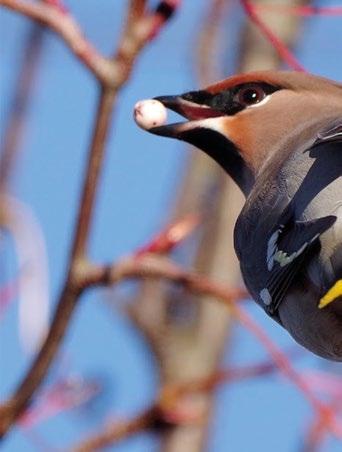

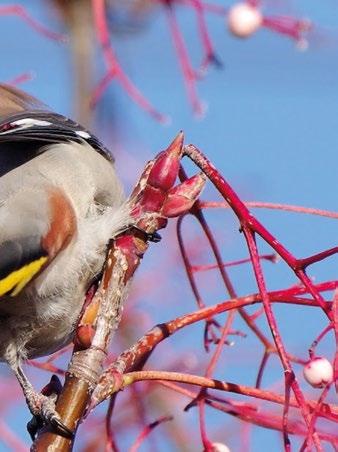
"Britain is a berry rich island, and we are lucky to host these partial migrants, even if only temporarily. "

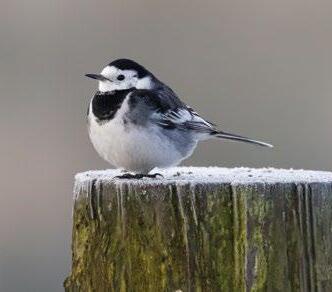

Pied wagtails are a native bird who also like to hop about the town over winter, eating insects, seeds and sometimes rubbish or household scraps scattered on the road. They wear a striking black and white pattern, but are most notable for their long wagging tail, bobbing up and down as they investigate what’s for dinner.
Like waxwings, pied wagtails charm us over the darker months by gathering in huge roosts at dusk in town centres and carparks. So, whilst doing your food or festive shop after work, look out for their bouncy flight and chipper calls, flitting from tree to bush. It’s guaranteed to brighten your chilly evening.
Winter can be a great time forwildlifespotting
wagtail numbers are also thankfully doing well, and they also have a green conservation status. However, they are daring little birds, darting through urban areas with a signature hop and a tail bob, giving us all the more reason to be wary and cautious whilst driving as the darker months draw in, as they have no fear of scooting across busy roads and carparks for food!
So, whilst we always welcome visitors to our nature reserves to take in the wonder of our winter wildlife, make sure to keep your eyes peeled for those serendipitous urban wildlife encounters too.
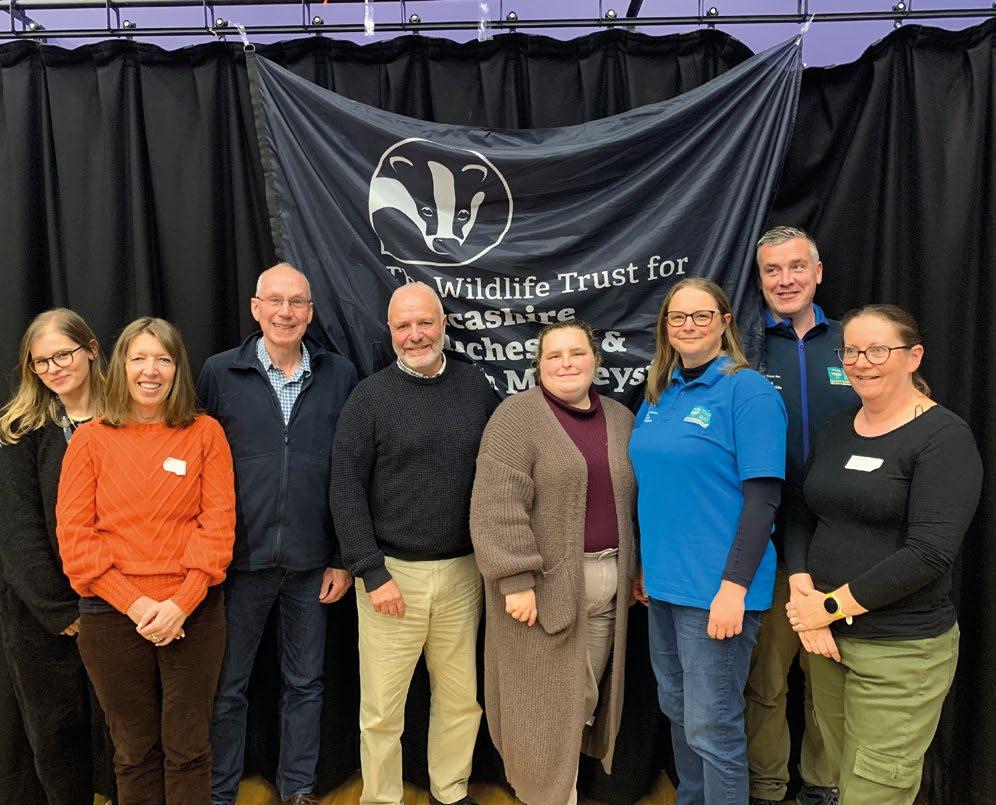
Countless individuals, community groups, schools, colleges and businesses across our region are dedicated to making a positive impact on nature. Anna-Maria White shares the inspiring stories of the award winners from our Supporter’s Day.
Our annual Supporter’s Day is a special event dedicated to celebrating our collective achievements, your invaluable support as members, and the dedication of our incredible volunteers. Our Action for Nature Awards recognise and honour the inspiring individuals who have made remarkable contributions to help restore and allow nature to thrive.
Unsung Hero – Anne Cooper
Anne started volunteering on our East Lancashire reserves 19 years ago and has been a vital part of the team ever since. She turns up in all weathers and will happily turn her hand to any task from clearing whole shopping trolleys of rubbish, assisting tree surveys, to raking acres of meadows.
Young Person of the Year –Lauren Fairfax
Lauren has been a vital member of LWT's Youth Council since 2023, making a valuable contribution to their advocacy and campaigning roles. She has incredible conservation knowledge and is currently employed as an ecological consultant. Lauren is a star on the rise!
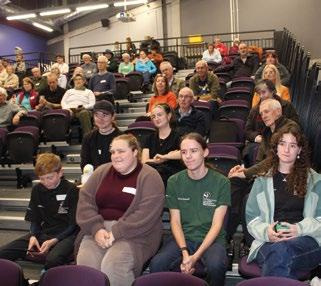

Most Inspirational Volunteer of the Year – Phil Shelley
Phil only started volunteering with us last year but has been an amazing addition to Lunt Meadows. He brings enthusiasm to every work party, has brilliant knowledge of birds and wildflowers, and is fantastic in welcoming new volunteers and assisting with our public events.
Volunteer Group of the Year – Brockholes Visitor Engagement Volunteers
Our Visitor Engagement Volunteers, based in the Welcome Centre at Brockholes, are truly the face of LWT. This summer they have racked up an amazing 1,781 volunteering hours, welcoming visitors, suggesting walking routes and wildlife to spot, and answering questions about the reserve and our work.

Achievement of the Year – The Seaforth Volunteer Group
After the devastating impact of avian flu on the common tern colony, the volunteer group helped to construct six brand new tern rafts for Seaforth and two at Mere Sands Wood. This year, the tern population has bounced back with the highest proportion of chicks to successfully fledge helping the population to recover.
Business Nature Champion of the Year – Wild Woolers
Wild Woolers (Helen and Beth) are a fantastic pair of creatives that make beautiful skeins and products such as mittens and socks using the wool from our very own conservation grazing sheep, donating 10 per cent of each sale back to LWT. They use natural dyes and traditional craftsmanship to create their pieces, giving our sheep’s wool longevity past their shedding season.
Nature Champion Community Group – The Bay-Wyre Nature and Wellbeing Group
Over the last year The Bay project’s Wyre Nature & Wellbeing group has made a huge difference for nature on their doorsteps, clearing scrub and invasive species, planting trees and bulbs, creating wildlife ponds, recording shark egg cases, building bug hotels, creating sand dunes with old Christmas trees, and removing 123 bags of rubbish as part of beach cleans!
If you’d like to nominate someone for our 2025 awards, keep an eye out on our social media channels and in our email newsletters from early autumn 2025.
Nature Champion Community Group (Urban) – St. Mark’s Church Group, Netherton St Marks Church in Netherton has shown how an urban pocket of land can be transformed for nature by turning their lawn into a wildflower meadow. It is now awash with wildflowers, butterflies and insects, inspiring nature-based art classes and other local groups and schools to take action for nature –demonstrating that no matter where we live, we can all help nature in our neighbourhoods.
The Andy Rowett Nature Champion Award –Julian Jackson
Dedicated in memory of Andy Rowett who sadly passed away in June 2024, who touched many lives over the years in his role as the Manager for Lancashire Environmental Fund.
Andy truly advocated for nature with an amazing breadth of knowledge and passion for the environment. We are delighted to award this to Julian Jackson, who joined as a Trustee in 2015 and has been instrumental in leading and supporting changes at the Trust to deliver more for nature. Much like Andy Rowett, Julian is a hardworking, caring person whose work has empowered others to act for nature, using his skills and expertise.
As we celebrate a decade of delivering our People’s Postcode Lottery Forest School project, Lydia German reflects on the incredible journey that has seen children thrive in natural environments across our region.
We’re very proud to now be in our 10 th year of delivering our Forest School Project, kindly supported by players of People’s Postcode Lottery. We work with urban schools in Liverpool and Manchester to deliver fun and inspiring Forest School programmes.
Forest School is a child-led, playbased ethos that allows children to explore, learn and play in a safe and supportive natural environment. Harnessing the power of nature to help children improve self-esteem, develop teamwork skills, and initiate their own learning outside of a classroom, Forest School is proven to not only help them grow as people, but also develop a genuine love of nature.
Throughout this project we have been able to work with more than 50 schools and thousands of children. Our knowledgeable education team pays weekly visits to the schools we partner with to deliver sessions with pupils, and they support schools to continue their Forest School journey once our involvement comes to an end.
For informationmoreabout our Forest School sessions, training,opportunitiesvolunteering and taster sessions emaileduadmin@ lancswt.org.uk

Over a long-term programme children are given the chance to play and explore their own interests, enabling them to direct their learning and develop a relationship with nature. They are supported to take risks and be independent, whilst fostering a sense of community amongst their peers.
"The children have really loved exploring the outside environment. The hands-on approach has really allowed children to experiment and enjoy learning without even realising."
Whether children are working together to build a rope ladder, collecting ‘ingredients’ to make a delicious mud pie, or building a whole village of dens, no two Forest School sessions look the same.
Students who take part are usually from a mix of year groups and are selected by the school to support their holistic development, fostering resilient, confident, independent and creative learners. Alongside our funded project, our experienced team helps schools from across our region in all stages of their Forest School journey, including delivering programmes, taster days or school grounds improvements.


We also offer Forest School Level 2 and Level 3 courses for teachers who can then continue the sessions beyond our time working with them.
The feedback from schools continues to shine. A teacher from St Mary’s C.E. Primary School in Manchester said: “The children have really loved exploring the outside environment. The hands-on approach has really allowed children to experiment and enjoy learning without even realising.”
Our vision is for a growing movement of primary schools across our region that are passionate about Forest School and the benefits it offers to learners.
"Harnessing the power of nature to help children improve self-esteem, develop teamwork skills, and initiate their own learning outside of a classroom."


To celebrate a decade of running the project, we commissioned a video to mark the milestone by Planet Shine, a film company focusing on sustainability, and a new LWT corporate partner.
The video focuses on St Wilfrid’s Primary School in Manchester, with school staff discussing the real transformation they have seen within their pupils. You can watch the video on our YouTube channel by scanning the QR code at the top of this page.
Thank you to players of People’s Postcode Lottery who have kindly supported this project for 10 years.


This year we said thank you and farewell to the Friends of Chat Moss. Formed in 2016, the Friends provided vital support to our Chat Moss peatland restoration efforts for nearly eight years.
While staff and projects came and went, the Friends provided important stability and continuity to the restoration of our Chat Moss peatland reserves, providing a font of knowledge to all who came across these amazing places.
From running information stalls, knitting frogs to fundraise, leading guided walks, maintaining a social media presence, to putting in hours upon hours of volunteering out on the reserves both recording and carrying out practical work. All members of the group were instrumental in the success of the area’s restoration – and they raised over £25,000 to help fund our peatland restoration!
All staff on the peatlands team agree that without the amazing efforts of the Friends, our sites would not be making the incredible strides to recovery that they are. A huge heartfelt thank you to all the Friends of Chat Moss, past and present.
Anna-Maria White shares how staff from across the Trust have been making a difference for nature.
Despite the enduring rain that has dampened so much of this year, here at Lancashire Wildlife Trust our staff, volunteers and supporters are always ready to roll up our sleeves and take action for nature.
There is so much that we can all do to make a difference to the wildlife, both on our doorsteps and in our precious wild spaces.
Check out just some of the things we’ve been up to:
pollinator
Back in July, we were approached by Petrus, a fantastic charity working to end homelessness, who had created the Kaleidoscope Ginnel Garden at this summer’s RHS Tatton Park Flower Show. Once the show had finished there were lots of surplus flowers and plant pots which needed to find a permanent home.
Everything was being shared out amongst lots of wonderful community projects across Greater Manchester, and we were lucky enough to have some donated to create a pollinator bar on my very own street in Stockport. Concerned about the lack of insects and butterflies this year due to the wet weather, my neighbours and I decided to get together to see what we could do to help.
As all of our front gardens are paved, there was previously little there to help support wildlife. However, with the help of the donated plants, seven households joined together to add hanging baskets and planters stuffed with pollinator friendly plants, creating a one-stop pollinator shop.
And our efforts paid off as we saw an influx of butterflies, bees and other pollinating insects arrive –especially to the vibrant purple-spiked speedwell that Petrus donated as the central focus of the pollinator bar which looked glorious.
This has been a wonderful project to share with my community and has proved that we can all do something positive for wildlife even if we don’t have a traditional garden.
"Concerned about the lack of insects and butterflies this year due to the wet weather, my neighbours and I decided to get together to see what we could do to help."
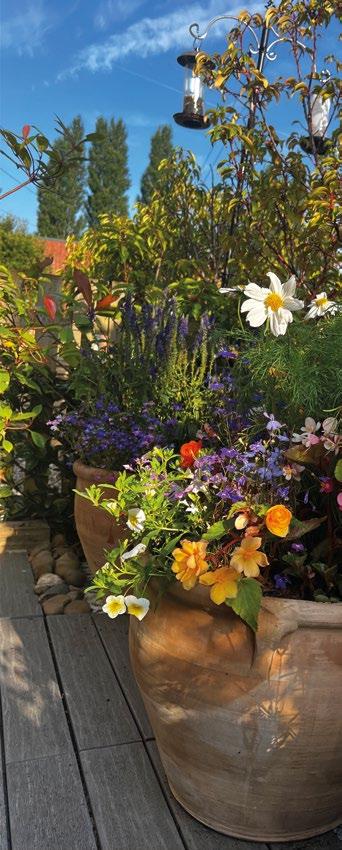
We would love to hear more about the actions for nature that you are taking too, so we have been working hard on creating our exciting new Actions for Nature Map. This is a super simple and interactive way that everyone can share the actions for nature you’ve been taking at home, at school, at work, and in your communities and groups.
Simply click onto the map and tell us a few quick details, and your action will be added to help inspire others and give us an idea of the fantastic work you are all doing. There are five different categories with some examples to help you in deciding where to place your action. Don’t forget to share a photo of your creations and actions as we love to see how you are celebrating and supporting nature.



Our staff never seem to sit still, especially not on our twice yearly staff practical days. Everyone from across the Trust gets together at different sites to get stuck into some hands-on conservation.
From balsam bashing and to sphagnum moss planting, to creating sensory gardens, this is a great way for people to get out from behind their desks and spend time with one another whilst all taking collective action for nature.
As a team we are committed to taking action for nature, and there’s always so much going on. We’d love to help and support everyone to take action for nature too, so please record your actions on our map and let us know what you are up to.



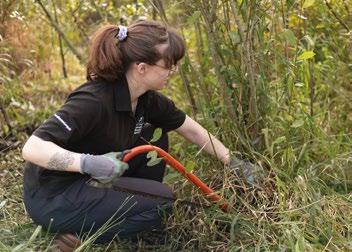
Jo Kennedy explains how we have been helping to shape vital plans for the future of our local nature.
Staff from across Lancashire Wildlife Trust have been supporting the development of Local Nature Recovery Strategies (LNRS) in each of the three responsible authority areas we operate in.
In Greater Manchester, conservation officers have advised on mapping approaches which set out where the best opportunities for nature recovery are, CEO Tom Burditt has chaired the Technical Advisory group for Liverpool City Region’s strategy, and LWT experts have contributed to habitat workshops in Lancashire - ranging from upland peat to coastal environments - to identify the priorities for action in the county.
LNRS’s are a new system of spatial strategies required by law under the Environment Act 2021, to show where and how we should be taking action for nature and providing wider benefits. The LNRS’s in our area are part of 48 covering the whole of England, making up a National Nature Recovery Network. Keep an eye out for more information once the LNRS’s have been published.
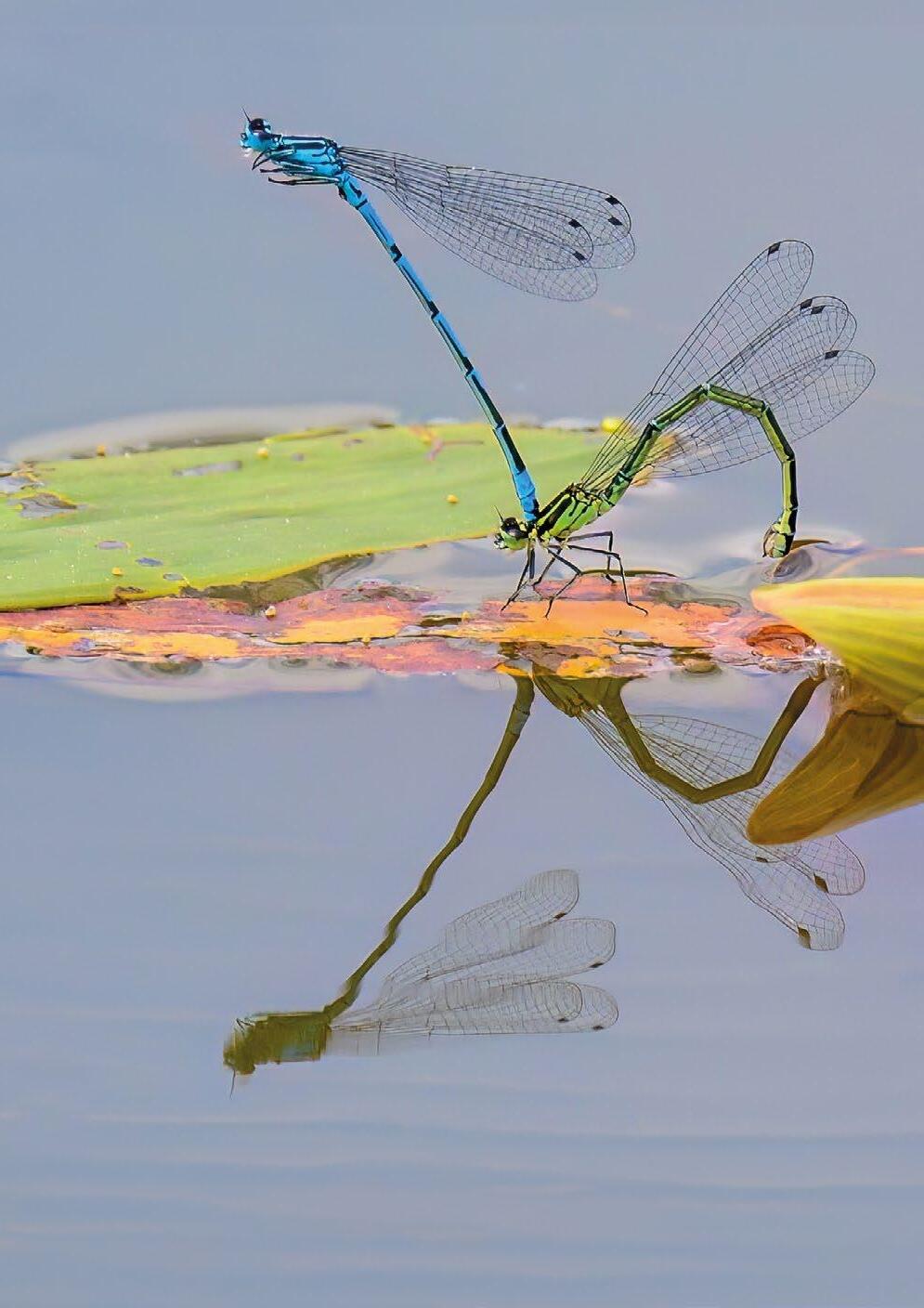
As winter arrives, we say goodbye to the wonders of summer and all the wildlife marvels that have been spotlighted throughout our photography competition. Alice Wood shows us more.
The photography competition continues to be sponsored by in focus, the binoculars specialist, who very kindly offer a £100 voucher as the prize each month.
Based in the Lookout hide at Brockholes Nature Reserve, in focus have a wide selection of binoculars and scopes to help you keep a closer eye on the incredible wildlife we are blessed with on our reserves.
With the cold winter months upon us, our budding photographers have their cameras and phones ready to capture the beautiful frosts, snowfall and starling murmurations of the season.
Our photography competition is open to everyone, and we love to see the incredible wildlife that you discover whilst out exploring our region.
Take a look at some of our previous photography competition winners. Who knows, you could be next!
We kick start our line up of winners with Min Yang , who was the winner of May’s photography competition with this beautiful yellow iris. This image fits the theme of Spring Blooms perfectly. Our judges loved how clear and vibrant the colour of the yellow iris is as it attracts the bee.
The way that Ken Hayes captured this orange tip butterfly feeding on a flower is spectacular. Our judges loved how the intricate details of the butterfly from its wings to its face, are so clear to see. The details captured, alongside the composition of the photo as this delicate creature perches on the flower to feed, made Ken’s image a clear winner of June’s competition in our judge’s eyes.
Carl Abbot took home first place in July with his beautiful shot of a goldfinch. The way that he captured the gorgeous colours of the plumage was incredible. The stance of this beautiful bird really made the composition of the image, as it bows its head, highlighting the striking red markings that are so distinctive to this special bird.
It is always so lovely to see the wildlife that can be found in our very own gardens. Peter Risley managed to photograph this humble hedgehog, which was awarded second place in July. This garden favourite, with its delightful button nose and ombre-brown spikes, was wonderful to see and really stole the hearts of our judges.
The winner of August’s competition was Sean Davis with a fantastic pair of damselflies. The composition and perfect timing of this image was a delight to see. Our judges loved everything about this image, from the stunning colours of these two damselflies, to the perfect arched reflection on the water.
Another fantastic entry from August’s photo competition was this beautiful damselfly taken by Andrew Spencer. The beads of water visible on the damselfly really captured a moment in time and impressed our judges. The clarity and stillness in this photograph really mirrors the calmness of the natural world.
If viewing these incredible images has inspired you to get out in the natural world and capture some wildlife shots, why not enterour competition? Take a look at the latest theme and find out how to enter at lancswt.org.uk/photo-comp


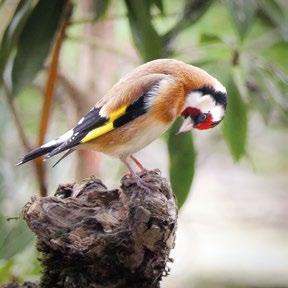

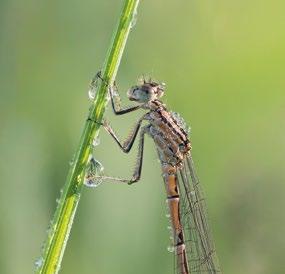
Staff from across the Trust are Stepping up for Wildlife and raising money for our appeal. Lucy Coxhead tells us what they’ve been up to.
Have you always wanted to challenge yourself with a 10k or even a marathon? One of our fabulous fundraisers, and our very own Communications Assistant, Amy, took on the challenge of a 10k run this summer, raising an incredible £309 in aid of our Step up for Wildlife appeal.
Amy said she was inspired by Barney, the resident, resilient, barn owl near her home who she regularly spots flying alongside the road. Barney refuses to stop roosting there, despite the development of houses on what has long been her home and hunting ground. Amy chose to fundraise to support our efforts to protect the areas wildlife call home.
Our Conservation team also challenged themselves to raise vital funds for our Step up for Wildlife appeal. Our Head of Land Management, Fiona, arranged the group challenge of walking the nine miles across Morecambe Bay, from Arnside to Grange, led by the Guide Over Sands Trust.
Fiona said of her motivation behind fundraising; “The wildlife in our region is extremely special and Morecambe Bay is a fabulous place to showcase just how beautiful it is. Wildlife is, and always has been, at the centre of my being and it is my hope that it becomes everyone else’s centre before it is too late.”
"We found people to be incredibly generous and were surprised just how much support we got simply by asking our family and friends to support us. People really responded to our cause, and that gave us a great feeling of community and contribution."


Lorna Bennett, Brockholes Reserve Officer, joined Fiona and Danny Myers, our Mere Sands Wood Reserve Officer and his partner Becky. Danny said of the experience; “We found people to be incredibly generous and were surprised just how much support we got simply by asking our family and friends to support us. People really responded to our cause, and that gave us a great feeling of community and contribution.”


"If you're inspired by our wonderful team or you've already got a fundraising idea in mind, we would love to hear all about it. "



The baking heat provided an extra challenge for the team to thealready new experience of walking barefoot across mud and sand for nine miles. An experience that spurred them all on during the walk was the osprey which flew overhead. It was a fitting reminder of the spectacular wildlife that they raised an incredible £889 for, as well as a symbol of hope for the future.
Could you challenge yourself and help fundraise for our Step up for Wildlife appeal? Get in touch at fundraising@ lancswt.org.uk
If you're inspired by our wonderful team or you've already got a fundraising idea in mind, we would love to hear all about it.
Let us know what event or activity you're planning to do, and we'll get in touch to provide you with help along the way.




Whether you are a dedicated student of moths, or simply wanting to identify the creatures in your moth trap, The Moths of Lancashire is a fantastic new book, full of photos and fascinating information.
Katharine Gilchrist, who regularly uses a moth trap at her family home, said; “The Moths of Lancashire is an expertly written and comprehensive publication which is a delight to own as a reference book based on almost two million records.
Beautiful photographs with informative and detailed text for each moth is accompanied by a handy map to show where and when the moths have been recorded over the last 200 years. Each section details the moth’s status in Lancashire, where it’s been recorded, its habitat and larval food plants.”
Brian Hancock, well-known for his publications on pug moths, added; “I like the way the authors have used so many photos by Lancashire moth recorders and mentioned by name many who have made some significant finds. It makes us all feel we have contributed just a little to this monumental work.”
Get your copy from all good booksellers now.

Contracts Manager, Steve Cowell , looks at the work of the LWT Contracts Team.
Nature Works won’t be familiar to a lot of people, but it’s the Lancashire Wildlife Trust’s contract delivery arm, carrying out work across the region and beyond.
Comprising of the Contracts Team and a specialist School Grounds Team, there are a range of project delivery skills available to clients.
The Contracts Team’s work programme is a blend of habitat management and restoration work, along with site access works, helping to bring people closer to nature. Our clients include local authorities, community and friends groups as well as the Trust itself.
Much of the work involves machinery, such as excavators and dumpers, and developing machinery skills within the team has enabled us to take on significant restoration and access work. An example of this is the creation and restoration of ponds under the great crested newt District Level Licencing Scheme, which the Trust administers in Lancashire under contract to Natural England. The skills within the team have enabled us to provide much of the practical delivery, and pond creation has become a regular feature of our work programme.
Other than the District Level Licencing scheme, pond and wetland work has always been a part of our job, and in January 2022 we remodelled the pond and boardwalk at the front of the Visitor Centre at Mere Sands Wood. Previous projects have also included the creation of a large pond at Euxton Millenium Green, and a water body for raft building and boating activities along with an associated wildlife pond at Guys Farm Activity Centre.
Our work takes us into some challenging locations, none more so than some of our peatland sites, where low ground pressure machinery and timber bog mats are required to prevent eight tonnes of digger disappearing without trace! The peatland work has also kept us busy, clearing birch scrub and planting many thousands of specialist bog plants.
We have also installed thousands of metres of path over the years, in fact the first project the team ever carried out was path construction at Mere Sands Wood. That first team was made up of employees who had formerly been on the Government’s New Deal training programme, which we were involved with at the time.
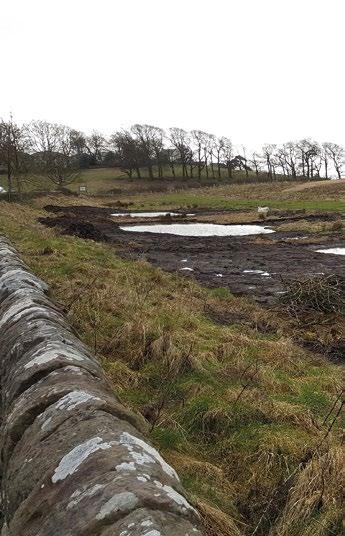

Do you have a project that our specialist Contracts Team could help with?
Things have moved on, and our most recent access project was at Freeman’s Wood in Lancaster. A site which is used and valued by local people, but with poor access, the Friends of Freeman’s Wood purchased the site on behalf of the community. They then engaged the LWT Contracts Team to install an accessible path, benches and welcoming signage.
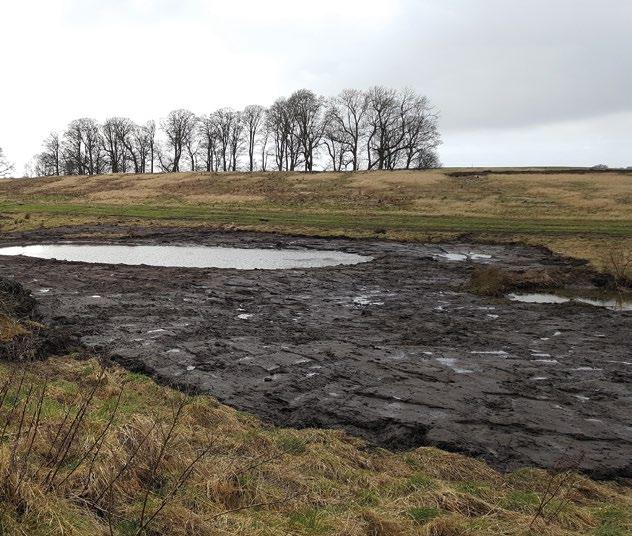

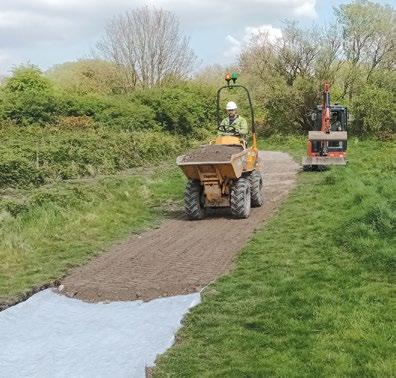
Managing and restoring habitats for the benefit of nature is fulfilling, but I find making places accessible for people just as rewarding as it can be transformative for local greenspace.
The response from the public to access improvements is almost always positive and - given good design - a whole new group of people who weren’t previously able or wanted to use a site can benefit. While we were working at Freeman’s Wood, Contract Team member Ryan summed this up perfectly; “We make a place that isn’t really anywhere into somewhere”.
"We make a place that isn’t really anywhere into somewhere."

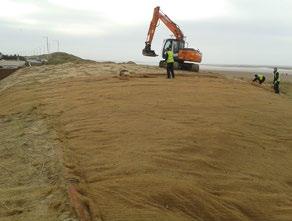
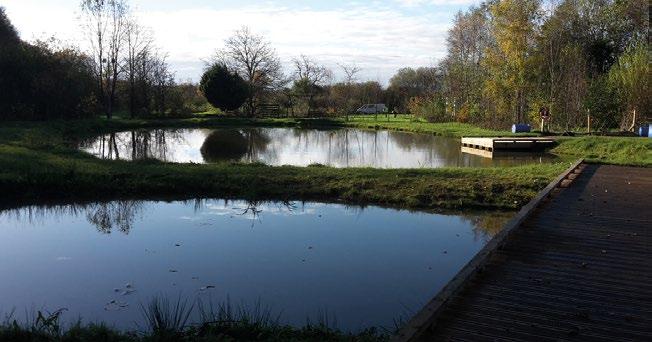
Surrounded by industry, Heysham Nature Reserve is a haven for wildlife. Reserve Officer, Reuben Neville , celebrates one of his favourite wild places.
“I didn’t know it was here” is a phrase that has been heard so many times when people have come to the reserve at Heysham, and this little gem is certainly tucked away. This year though, we celebrate a milestone, 40 years of the partnership between EDF and LWT. Lying on the coast at Heysham and owned by EDF who operate the two power stations here, it is around 16 hectares in area, part of which is designated as a Biological Heritage Site.
It is perhaps one of the Trust’s best recorded sites and the regular bird ringing that is carried out by the Heysham Bird Observatory group was in fact the starting point for interest in the area, even before the Trust became involved.
There has also been over 20 years of daily moth recording undertaken, plants and vegetation have been studied and mapped, and annual breeding bird surveys and butterfly transects are carried out.
"Our Connecting to Nature community project began 10 years ago, and to date has delivered over 15,000 days of activities connecting people to nature."
Reedbed and fen form parts of the lower reserve, while pockets of species-rich grassland and scrub are scattered throughout. More mature woodland has now begun to develop around some of the margins, and remnants of coastal heathland are to be found overlooking Morecambe Bay on the western fringe. Going down to the shore at Red Nab Rocks, a key high tide roosting site, intertidal rocks and small areas of saltmarsh support a further wealth of wildlife.
Its diverse fungi, including areas of waxcap grasslands, are well documented and detailed surveys have focussed on a range of invertebrate groups. Succession can seem like an unstoppable force, and to maintain such diversity in this situation requires regular, and sometimes innovative, management solutions. Over the years many volunteers and staff have given countless hours using both traditional, and trialling new, management practices.

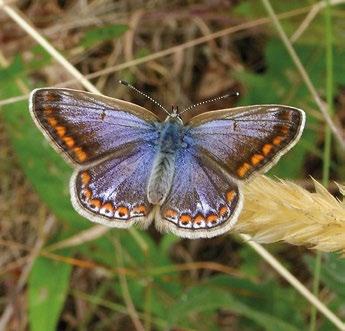
It is this concentrated diversity that also makes Heysham Nature Reserve so valuable as an educational resource, something that was recognised in the early years when the power stations organised visits for local school children and provided a field study centre in the centre of the reserve.
As with the natural succession of the reserve’s habitats, there have been changes, and in 2017 EDF replaced the original field centre with a new purpose-built combined office and classroom facility, even housing an inbuilt moth room.

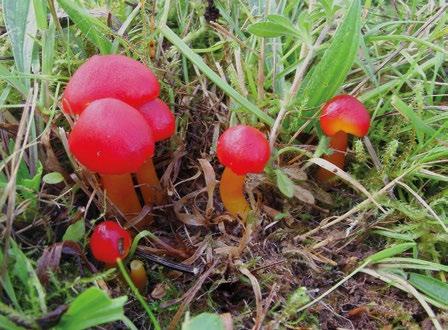
Our Connecting to Nature community project began 10 years ago, and to date has delivered over 15,000 days of activities connecting people to nature.
Welcoming new people and groups to the reserve and running a yearly programme of events, training, Nature Tots and Wildlife Watch sessions, it has also delivered reserve and outreach school sessions, engaging thousands of school children with local habitats and species.



To do justice to the last 40 years would rightly require a complete edition of Lapwing, but recognition must be given to the partnership that has developed over that time between the Trust and the power stations.
EDF support both the reserve and community staff at Heysham, funding two part-time Trust positions, while a number of dedicated staff within EDF have shared our vision and been instrumental in creating the partnership we have today. A partnership that has allowed us at the Trust to do what we do best.
In some ways the reserve here is a snapshot of much of our lost ‘common’ wildlife and a chance to travel back to a time when the countryside around us looked very different. It is also a vision of the future as we look to see how we can reconnect sites like this and create and restore sustainable ecological networks.
Finally, it is our chance to educate and inspire the next generation to ensure that we can look forward to writing the next article celebrating 60 years.

What is the Lancashire Wildlife Trust Youth Council, and what have they been getting up to?
Euan Norman tells us more.
As climate costs continue to take their effect on ecosystems and communities, is it any wonder that younger people have sprung forth with a desire to prevent further damage to their local areas and biodiversity?
This could not be more evident than with the Lancashire Wildlife Trust’s Youth Council. We are a collection of young volunteers aged between 16-25 with a passion for conservation and all things from the natural world. Everything, from interests in down-to-earth issues such as agriculture and soils, to the nationwide pollution of rivers, and the decline in insect populations.
As a collective we each share our separate skills and knowledge about our respective passions, to further each other's understanding of the obstacles facing a greener future.
"We are a collection of young volunteers aged between 16-25 with a passion for conservation and all things from the natural world"
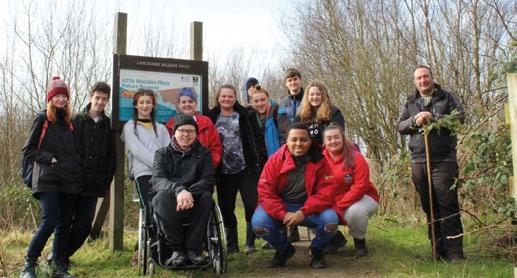
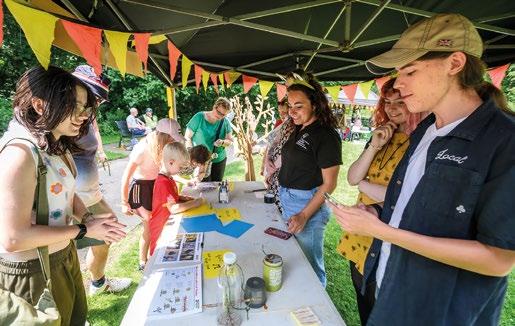
Currently, we are a team of 14 young adults from across the North West, who meet up bi-monthly to discuss aims, plans and events we can become involved with. Whether it is running activities at the Manchester Festival of Nature, attending the Green Party Conference or visiting 10 Downing Street to deliver a petition addressing the ecological damage of HS2’s construction.
This summer one of our Youth Council members, Naeha Ganger, took part in the Restore Nature Now march in London; “I’ve always appreciated our right to peaceful protest and have been inspired by activists such as Greta Thunberg. I was completely blown away at the scale of the march and the passion everyone exhibited for a common cause.”

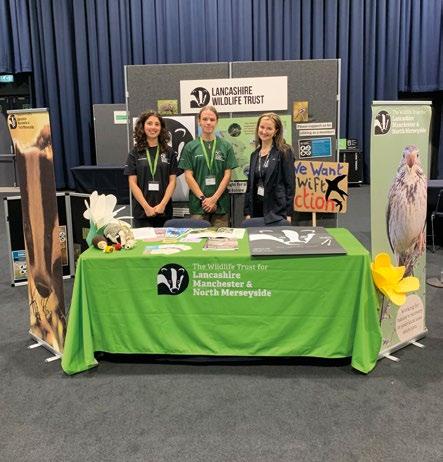
Our members also get involved in practical conservation work in a variety of habitats across our region, including planting sphagnum moss on our peatlands and removing invasive species from the Fylde Sand Dunes.
Youth Council members are offered additional training and support from the Trust, empowering them with a wide range of skills to further their chosen careers. “These are a great opportunity to make new connections that will help me in my future career paths,” said Tammy Winters, Youth Council member.
Thanks to the Lancashire Wildlife Trust’s Step Up for Wildlife Appeal, I have recently been appointed as the Youth Council Assistant Officer, to keep all members aware of activities and meetings that they can participate in.
Follow the Youth Council on Instagram @wilder_youth
My goal is to get more young people involved with campaigns, volunteering and conservation work. I had been a member of the Youth Council for a year before my appointment into this role, and I am eager to help others receive the same opportunities that were granted to me.
Our new members are full of enthusiasm and ideas. We have already made links with other youth projects, as we believe that working together is a great way to pool our resources, knowledge and help us to shape the future for wildlife that we wish to see.
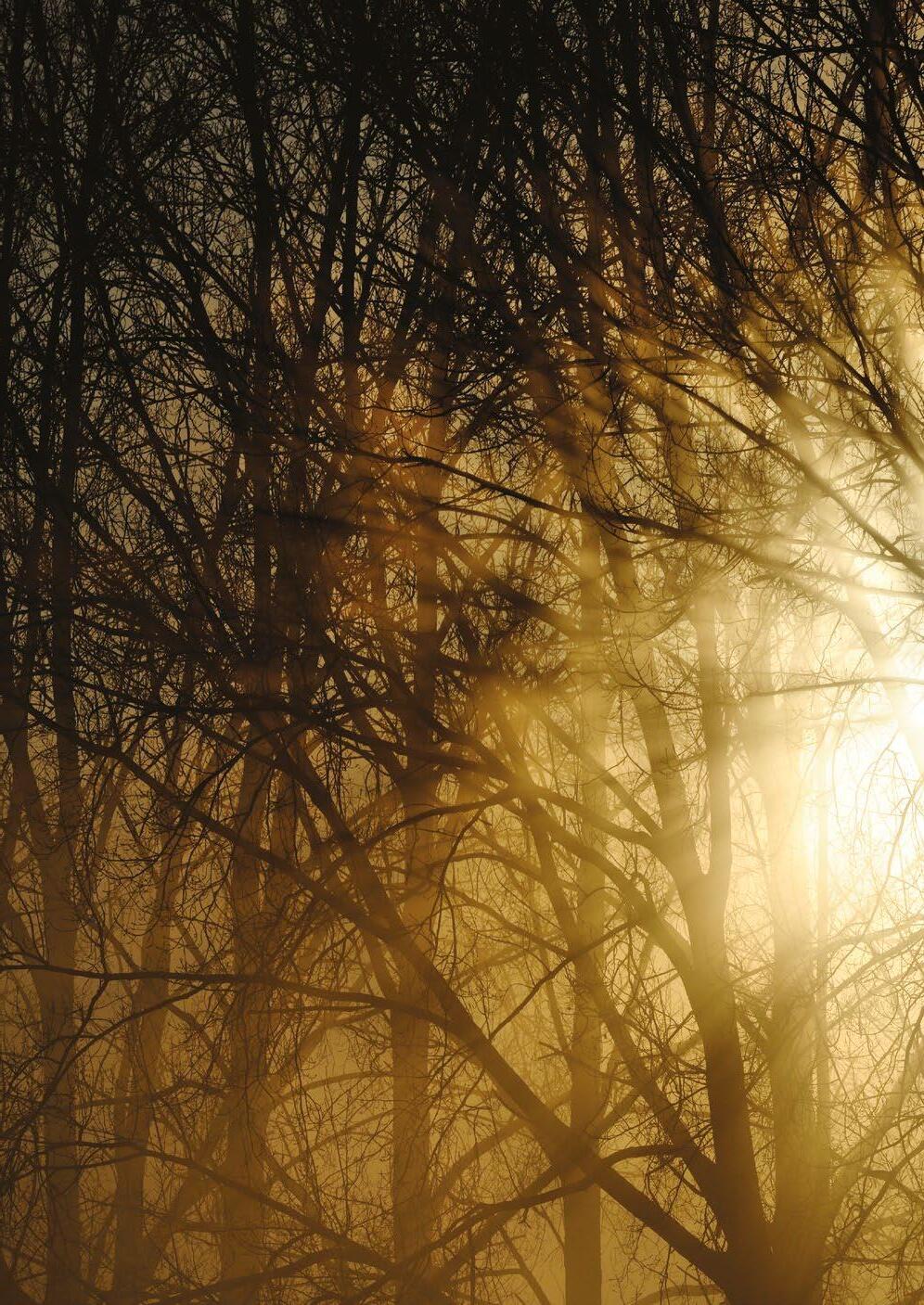
Some days it feels like we are in a desperate scramble to respond to the challenge of species and habitat loss, as well as an intensifying climate emergency. One upside of our experience of the sharpness of urgency has been a broadening in the category of environmentalism. Now it includes new or previously marginalised stakeholders and overlooked forms of care for nature.
As a general rule, sustainability has tended towards a default of elite, white, secular and scientific. In the research I was involved in last year on project Spotlight*, we identified a massive upswell of enthusiasm for environmental care and action among people of colour in the UK. A significant number of our respondents also linked their concerns to religious and spiritual traditions and identities.
These finding supported work I’ve done alongside everyday activists and environmentalists, where I’ve seen an exciting range of new initiatives coming up in the context of religious communities. This includes the Sikh Guru Nanak Sacred Forest project, aiming to establish a new network of sacred forests across the world. British Muslims are drawing on the Quran and Hadith to reclaim forms of thoughtful stewardship of nature.
This can also be seen in urban ecology projects: British Bahu Trust mosques are covered with solar panels and proactive in leading community clean-ups. Cambridge Central mosque is a true eco-mosque with a near-zero carbon footprint. The Eco-Church network, has grown from 250 to more than 5,000 British churches in a decade, making it one of the largest community networks of local environmental action groups in the UK. Woodlands, nature reserves, and other nonreligious environmental charities are also connecting with their stakeholders in more holistic ways. Given that so much of our work restoring the landscapes we care about is about
re-establishing forms of connection, it makes sense that many people are re-discovering their own environmentalism in the context of personal faith and spirituality.
But while conservation as a genre is opening up, there is still a lot of work to do. Are there aspects of ourselves that we still hold back and fence off from our concerns for wildlife? For example, the natterjack toad, hazel dormouse and hedgehog are all under threat of extinction. We might try to stretch our awareness to bring creativity to forms of love for creatures that we might find unlovely or pause to learn about new kinds of beauty.
By bringing spirituality to nature it can also help us navigate feelings of loss and disconnection, like the process of mourning a lost-through-melting Icelandic glacier. This might take the form of a slow walk, drawing close and leaning in to nature, even though we may want to flee for fear of grief. Why not treat walking footpaths, hills or the spectacular but fragile British peatlands as an eco-pilgrimmage?
It’s especially exciting to me that we are finally bringing spirituality to nature conservation as this can help us to forge deeper relationships, harmony and forms of connection with habitats and creatures.
*Project Spotlight is an initiative engaging people of colour with nature and climate change. You can learn more about the project at climateexperiences.org
This article by Jeremy Kidwell precedes an upcoming blog series by The Wildlife Trusts exploring the intersection of nature conservation and climate change, religious faiths and spirituality. Starting towards the end of 2024, each blog will focus on religious festivals or awareness days that highlight diverse spiritual perspectives on the natural world. View all blogs from The Wildlife Trusts at wildlifetrusts.org/blog

Jeremy Kidwell is an associate professor in theology at the University of Birmingham. He is the author or editor of a range of books including most recently a collection of essays edited with Stefan Skrimshire called Religion and Extinction.

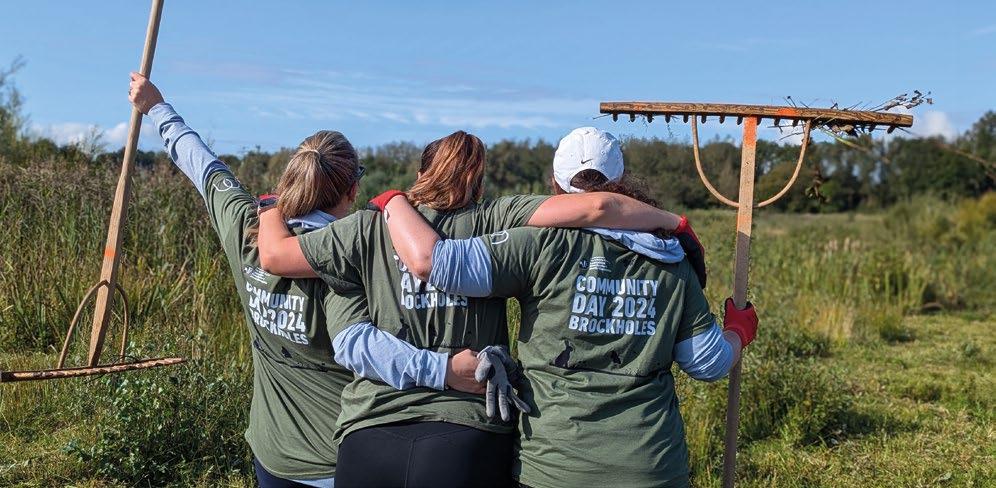
Partnerships Manager, Megan Kelsall , gives us a round-up of the latest news from our corporate members and supporters.
Welcome to our new members
We are delighted to announce our new Gold members, The Senator Group. I recently went along to their HQ in Accrington, not too far from our own Foxhill Bank Local Nature Reserve, to meet with the team. I’m now helping to plan a series of events over the next couple of months across their sites focussing on the relationship between people and nature, what you can do for wildlife, and what in turn nature can do for you. The team are interested in our Nature and Wellbeing programme, as well as supporting us with upcoming fundraisers.
Spreading their support even further through the Wildlife Trust network, we welcome Professor Alexander J Smithson from Orosurgeon Ltd as a Gold member. Already a member of Cumbria Wildlife Trust, Orosurgen Ltd has chosen to take action for nature across Lancashire, Manchester and North Merseyside too. Ibis Manchester Centre Princess Street have also joined as a local branch and a valued Bronze level member along with Glasdon Group Ltd We were delighted to welcome Glasdon to our own Brockholes Nature Reserve, when it was used as the location for a photoshoot of for their new product line. Thank you for joining our green network of incredible corporate supporters.

We are proud to have worked together in partnership with Southport FC on our raising awareness initiative. Southport FC, now under new ownership, got in touch with our team with the aims of refurbishing an old match fixtures sign on the boundary of our Freshfield Dune Heath Reserve, overlooking the Formby by-pass.
With the hope of encouraging both our football and nature lovers to take action both on and off the field, Southport FC also offered us a signage space at their Haig Avenue stadium.
We can’t wait to join them on match day and show the team some support. Come on the Sandgrounders!
Thank you to all the teams we have welcomed onto our reserves over spring. Groups from all over Lancashire, Manchester and North Merseyside have booked on to our Welly Workout days to get stuck into some hands-on conservation.
Gorilla Glue joined us again this year, catching the last of the summer sun on a glorious day at Brockholes Nature Reserve. Following a successful community day in 2023 at Mere Sands Wood, 50 team members volunteered their time at Brockholes to help us tackle some non-native species removal, along with raking cut grass to remove it from our species rich meadows and retain the biodiversity value.
The team members worked together to help our conservation team all whilst sharing quality time in nature and connecting with wildlife. Our Brockholes team were grateful to welcome so many willing volunteers on to site to tackle such a big job.
To celebrate their success and refuel after a busy morning, the whole team then headed to the Visitor Village to enjoy a hot lunch at Kestrel Kitchen and spent the afternoon exploring the reserve.
Our Greater Manchester Environment Fund Communications Officer, Annabelle, sat down with our Fundraising Manager, Lucy, to discuss what prompted her to write her will using our free will writing service.
Why did you start thinking about writing your will?
I’m approaching my 30th birthday and since buying my house in 2019 and getting married in 2021, I’ve been vaguely aware that I should probably get a wiggle on and write a will.
However, it never seemed to be the right time to actually do it. And if I’m honest, I didn’t even really know how to begin, how much it would cost, or what it would involve. I thought I might need to instruct a solicitor or that it would be a laborious process. I wouldn’t say I’m scared of dying but I’m definitely not thrilled about the paperwork.
During Remember a Charity Week, I overhead my colleagues discussing the free will writing service available through the Lancashire Wildlife Trust, and it seemed like the perfect opportunity to finally sort it out.
Why did you decide to leave a gift to Lancashire Wildlife Trust?
Over the last few years my relationship with the Trust has evolved in a lovely way: I’ve gone from a member, to a volunteer, and then to an employee in my current role with the GMEF.
The will writing service offered by LWT through Octopus Legacy smoothed out all the qualms I was having about my will. Not only is it free, but it’s all done online in a very clear and concise way and was a lot simpler than I expected. I think it took me about 15 minutes from start to finish, and I didn’t need to fish out any documents about my house or my bank account. Leaving a gift to LWT in my will is my way of saying thank you for providing this service, as well as ensuring that my love of helping wildlife continues after I’m gone.
What impact would you like your legacy to leave?
As someone who works with the Trust every day, I’m privileged to see the importance of each penny that’s donated, and how many brilliant projects and species benefit as a result. I’d love for my legacy to end up benefiting water voles somehow, as my first experience volunteering with the Trust was on a water vole habitat improvement project in Wigan, so they’ve had a special place in my heart ever since.
That said, I hope it’s a very long time before my legacy comes into being, so I’d be happy for it to simply be directed in the way it’s most needed at that time.
What would you say to others who are thinking of leaving a gift to LWT in their will?
I think leaving a gift in your will is a meaningful way to protect the things you care about for future generations. I like knowing that after I’ve shuffled off this mortal coil, my gift will be there to give back to the county and the wildlife that has brought so much joy to my life. I think anyone who wants to leave behind a legacy that will make a difference, big or small, should think about leaving a gift in their will.
Thank you to our Step up for Wildlife appeal corporate supporters









GOLD
– Beechfields Brands
– Close Brothers
– Eric Wright Group
– Evans Vanodine
– Gresham Office Furniture
– Little Green Feet – JBI Ltd
– Mace
– Northstone
– OroSurgeon Ltd
– Places for People
– Planet Shine
– Senator Group
– Siemens
– Standby Productions
– Volker Stevin
– VP plc
– Victrex
SILVER
– Decordia Ltd
– Dock10
– Fort Vale Engineering Ltd
– Making Energy Greener
– MJ Wilkinson Plant Hire
– Southport FC
BRONZE
– Cavendish Nuclear
– Glasdon Group Ltd
– Ibis Manchester Princess Street
– Stowe Family Law
– Valley Mist
– Weinerberger
LOCAL BUSINESS MEMBERS
– Hoofs & Paws
– Moss Wood Caravan Park
– Wild Woolers
– Worthington Sharpe Ltd
Also special thanks to other businesses that have generated income, taken part in Welly Workouts or given in kind materials and help to projects this last quarter: Siemens, Wildlife Travel, Morgan Sindell Construction, Eric Wright Constuction, VercoGlobal, Laing.
At Lancashire Wildlife Trust we believe that business charity partnerships should be mutually beneficial and based on shared values. Our partnerships are bespoke not “one size fits all” packages. It’s important to us that we get things right at the start to make sustainable long-term relationships. We believe that your company can benefit greatly from a partnership with Lancashire Wildlife Trust as we help your business and your staff to connect more with nature and thrive from the health and well being that happens from connecting with their outdoor environment.
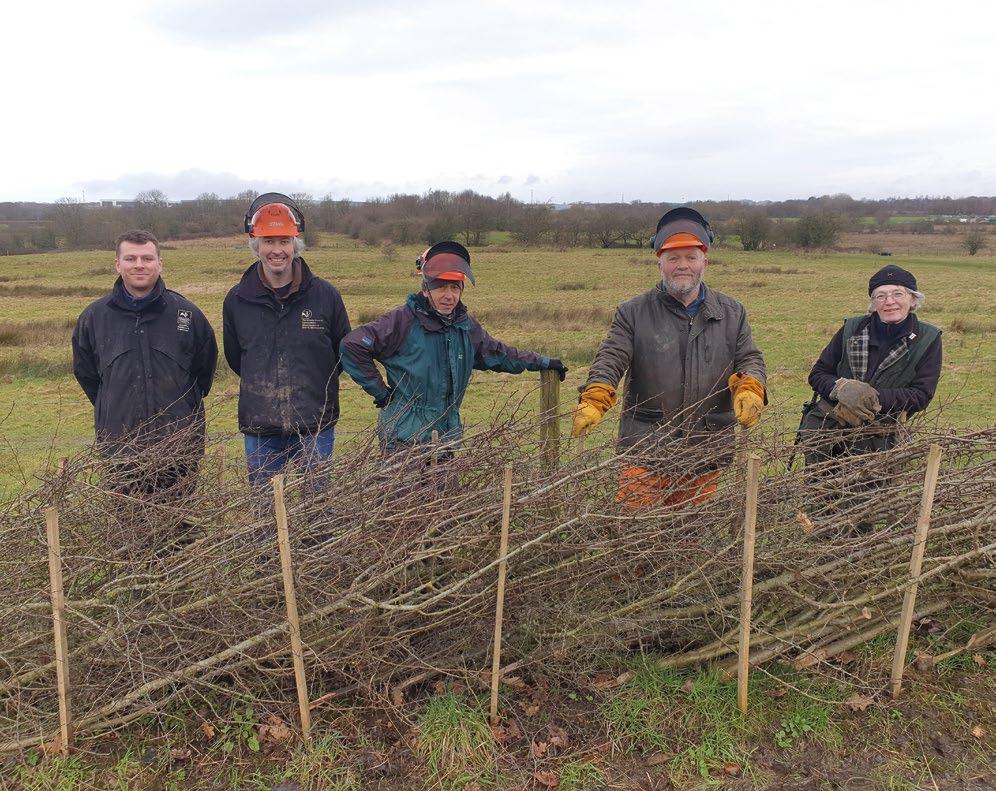
Jenny Bennion has been busy learning the traditional art of hedgelaying and finding out why it is so important for wildlife.
Hedgerows can be amazing, but many of our hedges are bare all winter with huge gaps at the bottom plugged by metal fencing. The traditional art of hedgelaying can be used to create thick strong hedges that are fantastic for wildlife.
Not only do thriving hedges provide food and shelter, but they also act like motorways, allowing species to move around safely, accessing new habitats and enabling populations to spread and connect. However, we have lost 50 per cent of our hedgerows since World War Two – and around 60 per cent of the hedgerows we still have aren'tin good condition.
Happily, we are lucky enough to have a band of conservation officers and skilled volunteers that work to lay hedges across many of our nature reserves. Take a trip around our patch and you might spot laid hedges at Brockholes, Foxhill Bank, Cutacre and in Phillips Park.
I recently spent a day joining the hedgelaying team at Phillips Park where funding from the National Highways Network 4 Nature scheme has supported volunteers to lay and regenerate 150m of hedges.
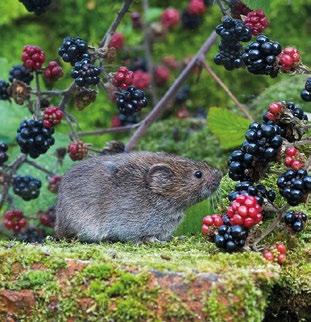

My tutor for the day was volunteer Francis Williams, a true master of the hedgelaying art. We stacked our tools in Francis’s trusty repurposed golf trolley and set off for our section of overgrown hawthorn hedge.
The principle of hedgelaying is to take the upright stems of the plants which are forming the hedge, make a cut into them near to the base, but not all of the way though, and then lay these stems (also known as pleachers, or liggers in Lancashire dialect) at an angle along the length of the hedge.
The pleacher stays alive, sprouting leaves and more branches throughout the growing season which help to strengthen and thicken the hedge, whilst the remaining stump (the ‘heel’) acts as if coppiced and sends up new stems which in time will be laid into the hedge to maintain it.

"A laid hedge is thick and strong, providing the perfect habitat for birds to nest, insects to shelter, and mammals and reptiles to safely move around."


This may all sound simple, but I can promise you – it’s not! Through years of accumulated skill and knowledge, Francis can look at an area of hedge and know exactly which stems to take out and which to lay to ensure the hedge is thick and strong for at least the next 10 years - by which time it will be ready to lay again with new stems that have grown from the heel.
The next step is to create the perfect pleacher, a long tapering cut that starts four times the width of the stem up on the opposite side to where it will bend. The heel retains most of the span of the stem with the pleacher hanging on by just a thin strip of wood.
A few thwacks from Francis’s trusty billhook (you can also use an axe or a chainsaw) should have been all it took, but most of my cuts ended up in the wrong place.
However, Francis’s extremely patient guidance saw me get there in the end, with pleacher formed, heel tidied up, and stem laid alongside the others forming the new section of laid hedge.
You can learn new skills and meet new friends by volunteering on our nature reserves
A laid hedge is thick and strong, providing the perfect habitat for birds to nest, insects to shelter, and mammals and reptiles to safely move around.
I can confirm that hedgelaying is a joyous artform. One which my farming grandad was a champion at – and one which I could happily spend all day, every day learning to perfect. These traditional skills have lasted for a reason and show how human action and supporting wildlife can go hand in hand.
Winter is the most wonderful time of the year. Our nature reserves transform as colder weather sets in and seasonal wildlife flocks to our shores.
Wrap up warm, get outside and explore one of our fantastic reserves this winter.
Brockholes Nature Reserve 6th and 13th December
Tickets: £12.00 per person
Step into a winter wonderland filled with Christmas lights, artisan markets, delicious food and drink stalls, and even a chance to meet Santa himself. Get into the festive spirit with live music and traditional fairground games. Brockholes Winter Fayre is the perfect way to kickstart your seasonal celebrations.
Brockholes Nature Reserve
Dates throughout December
£13.95 per child
Santa is back at Brockholes! Come and meet him in his workshop, set against the backdrop of our beautiful Meadow Lake.

Brockholes Nature Reserve, Moss Bank Park and Queen’s Park
Dates throughout December
£9.99 per pack
Write your letter to Santa at home, before heading off on a winter walk to Santa’s Post Box following our self-led trail.
Brockholes Nature Reserve
Dates throughout December
Free
Located on our unique Visitor Village floating on Meadow Lake, we are inviting artisan businesses from around the North West to showcase their products and create a brilliant, unique market.
Brockholes Nature Reserve,
The Café at Moss Bank Park and Queen’s Park Café
Dates throughout December
Adult ticket: £11.95
Child ticket: £12.95
Join us for our super special Breakfast with Santa event to add that extra bit of magic to your child’s Christmas this year.

Guided Walk
North Beach Car Park, St Annes
Dates throughout the winter Free
Come along and discover the wonders of the Fylde Sand Dunes with our passionate and informative volunteers.
Heysham Nature Reserve
Dates throughout the winter
£3.00 per child
Join us to explore the natural world out on the reserve in this interactive Nature Tots session at Heysham Nature Reserve.
Numerous sites across our region
Dates throughout December
£4.50 per child
Wrap up warm and come and Xplore! Discover our wild places, find Christmas themed markers, complete the Xplorer Challenge and have fun together.
Mere Sands Wood Nature Reserve
Dates throughout December
Join us at Mere Sands Wood this festive season for our brandnew Brunch with Santa event. Take part in a fun-filled morning with the whole family! Enjoy a delicious brunch, see Santa himself and get in the Christmas spirit surrounded by wonderful nature.
Adults ticket: £9.99
Childs ticket: £6.95
Brockholes Nature Reserve, The Café at Moss Bank Park and Queen’s Park Café
Dates throughout December
Adult ticket: £12.95
Child ticket: £14.95
Join us for Supper with Santa. Delight in a charming festive meal, meet Santa Claus and create magical memories to last the year.
The Hive at Moss Bank Park
Dates throughout December
£9.95 per child
Santa's Grotto is a magical experience where children and families can meet Santa in a festive, beautifully decorated setting. It offers a magical experience with photo opportunities, holiday decorations, and a special gift for children!

